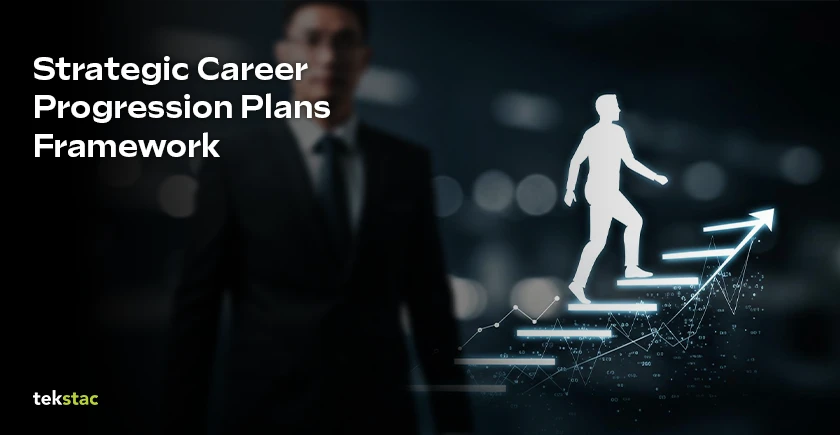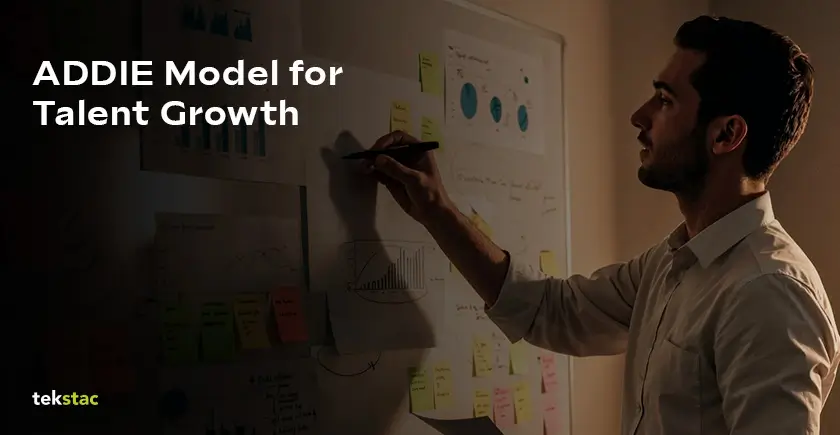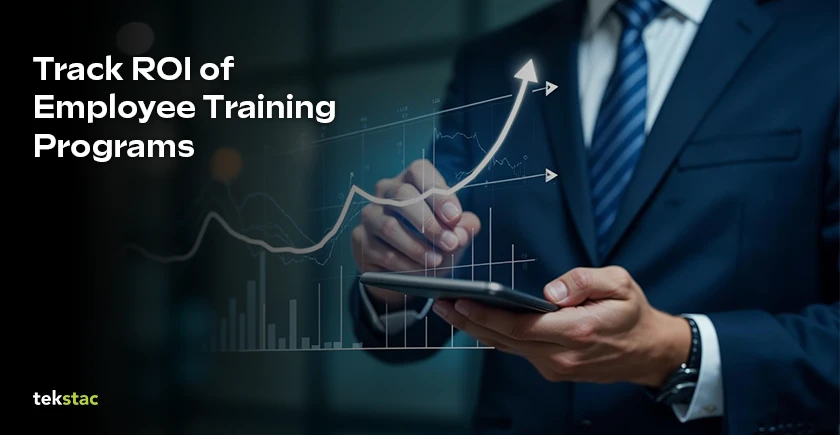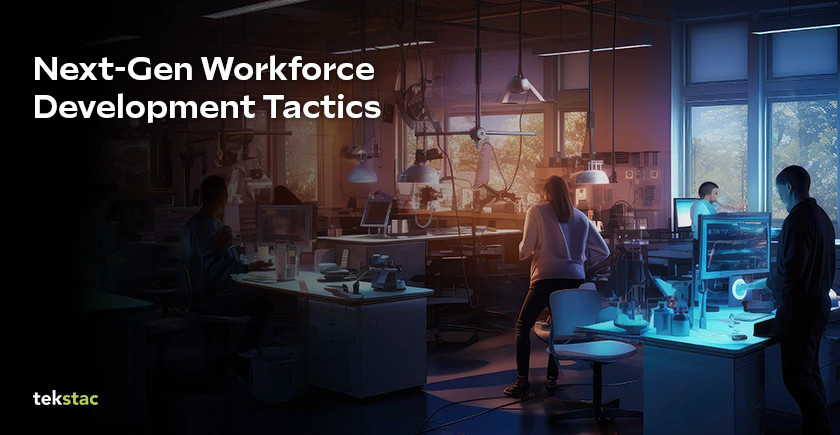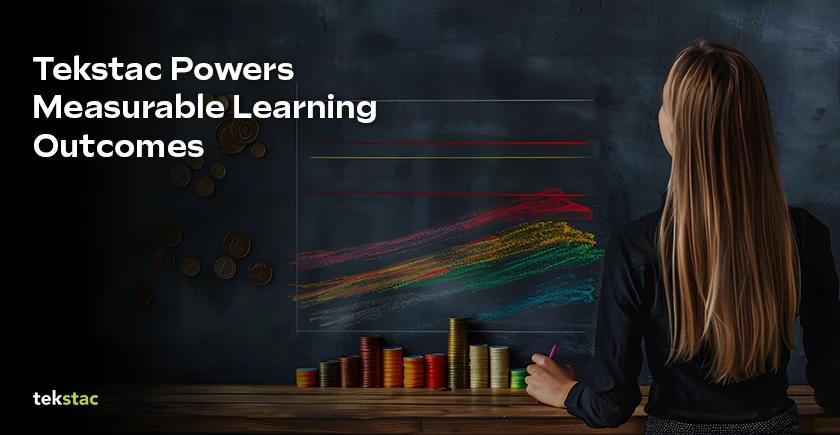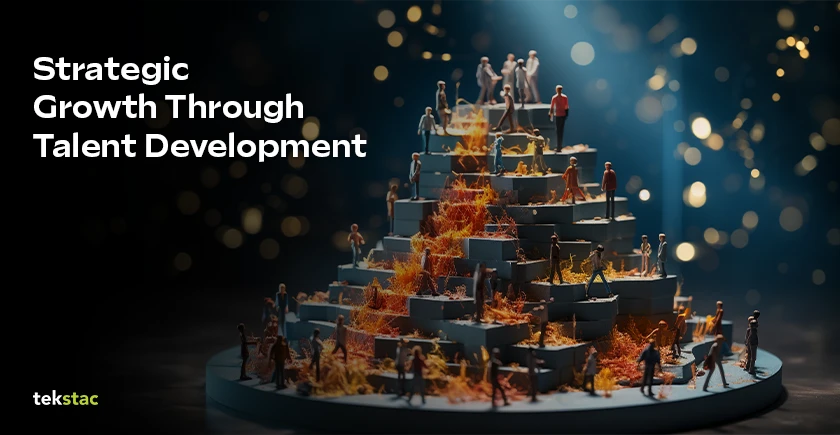Career Progression Plans: Aligning Employee Goals with Business Objectives
Why Traditional Career Progression Plans Fail
Your best engineer just left.
Again. Official reason?
“Looking for better growth opportunities.” But let’s be real, they just couldn’t see a future here.
Now the team’s left picking up the pieces, and you’re stuck trying to figure out promotions with half-baked feedback and gut calls. You’re hoping you’re getting it right, but deep down, you’re not sure.
And it’s not just about losing one person. It hits harder, and morale dips. Work slows down.
The problem?
Most career progression plans are just broken. Too much guesswork. Too much politics. Not enough clarity or fairness.
So yeah, it’s not just a one-off. It’s a pattern. And if nothing changes, the best people will continue to walk out the door.
The Brutal Reality Behind Failed Career Systems
Here’s what’s happening in your organization under the guise of employee career development:
- The visibility trap: The ones who speak up the most often get noticed. They get promoted. Meanwhile, the quiet high-performers keep delivering real results but stay under the radar. Over time, that lack of recognition turns into quiet frustration. The potential is there, but it’s left untapped.
- The title inflation game: New senior titles keep getting created, but nothing changes in the work or responsibility. It just adds noise. Teams often get confused, and external candidates struggle to understand the actual meaning of these titles.
- The management bottleneck: Every promotion or role change depends on managers who are already overloaded. They are short on time and stretched to the limit. That leads to delays, inconsistent decisions, and people feeling stuck without a clear way forward.
- The skill speculation problem: People are being judged based on assumptions or how they perform in interviews rather than on real, proven work. This leads to mismatched roles, frustration, and a disconnect between potential and performance.
Research from Deloitte shows that replacing a senior engineer can cost up to twice their annual salary, but the real damage is the knowledge walking out the door, stalled projects, and demotivated remaining teams.
Build Career Progression Plans That Work
It’s time to treat career development like a well-engineered system—methodical, data-driven, and continuously evolving.
- Map Observable Skills, Not Fluffy Titles.
- Design Flexible Career Progression Plans, Not Ladders.
- Replace Annual Reviews with Continuous Evidence Collection.
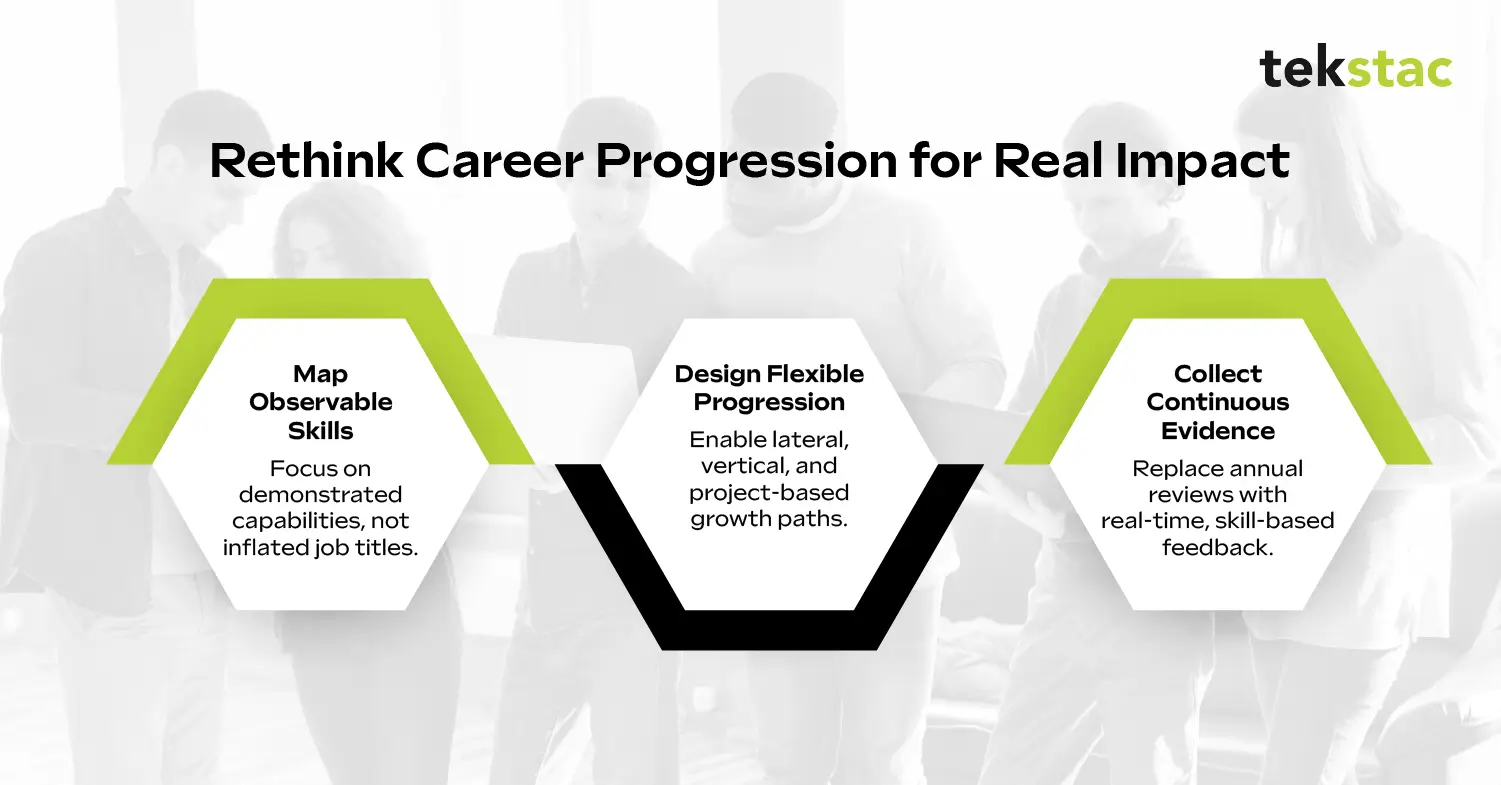
1. Map Observable Skills, Not Fluffy Titles
Define what people can do—don’t rely on vague titles.
- Concrete capability clusters: For example, “designs and deploys scalable microservices capable of handling over ten thousand concurrent users with high uptime” provides leaders with clarity and engineers with purpose.
- Real-world problem complexity: Track someone’s ability to identify and resolve tricky production race conditions under pressure rather than just attendance or code volume.
- Context‑specific abilities: Recognize that excelling at legacy refactoring is different from greenfield architecture; both deserve acknowledgment, but they require clarity of context and measurement.
- Measurable depth indicators: Map progression from “needs guidance to implement” up through “independently leads and mentors peers on advanced patterns across projects.”
2. Design Flexible Career Progression Plans, Not Ladders
People don’t grow in straight vertical ladders—they flourish across diverse, evolving career pathways.
- Multiple advancement paths: Create distinct tracks, such as technical specialist, engineering lead, or systems architect, allowing engineers to grow based on impact rather than role or hierarchy.
- Lateral skill expansion: Enable transitions, QA engineers developing DevOps proficiency, backend developers learning security best practices, or data analysts moving into product analytics without penalizing them for sideways moves.
- Diagonal capability building: Encourage growth at the intersection where senior developers adopt product thinking or engineers begin to develop core business strategy acumen, bridging gaps across teams.
- Dynamic role evolution: Refresh and adjust tracks quarterly to reflect changing priorities, new tech stack investments, or emerging business needs, keeping growth aligned with the company’s direction.
3. Replace Annual Reviews with Continuous Evidence Collection
Why evaluate performance once annually when engineers are evolving daily?
- Project-based skill demonstration: Every code review, production deployment, and architecture session becomes a data point that evidences capability development and tangible impact on business outcomes.
- Peer validation mechanisms: Structure input from the teammates who work with someone every day. This gives a much clearer picture of how they collaborate and how much trust they’ve earned within their domain, compared to just relying on top-down reviews.
- Real-time capability dashboards: Make individual progress visible to engineers, managers, and leaders alike, highlighting strengths, areas for growth, and potential next steps at any time.
- Transparent progression criteria: Publicly share what’s required to advance to the next level, removing guesswork, bias, and inconsistency in promotions or recognition.
Embed Talent Management Strategy with Business
This is not a nice-to-have. It’s a competitive business advantage when engineers’ growth aligns with organizational growth goals.
- Align skills with business direction: Don’t invest in declining languages or tools. Focus on where your roadmap is headed, whether it’s AI platform development, full-stack expansion, or reliability engineering.
- Future‑focused capability building: If your strategy includes an AI-native architecture, build machine learning fluency across engineering teams, not just within one silo, through targeted learning paths and live projects.
- Platform transformation readiness: While migrating to cloud-native systems, fast-track engineers who have already demonstrated the ability to work with microservices architecture, container orchestration, and resilience patterns.
- Cross‑functional bridge building: Encourage engineers to speak product language, especially when customer experience becomes the competitive edge, improving communication, alignment, and solution quality.
Strategic workforce intelligence: Use real-time, anonymized skill data to answer critical questions: “Are we technically ready for our next 18-month roadmap? Who’s closest?“—without gut guessing.
Make Succession Planning Engineering‑Grade, Not Crisis‑Driven
When leaders leave, don’t scramble. Plan ahead.
- Capability trajectory tracking: Spot the people who are growing in both technical depth and influence across the team. This helps you understand who might be ready for bigger roles before you’re forced to make urgent decisions.
- Experience gap bridging: Give engineers the kind of stretch opportunities that actually prepare them for what’s next. Let them lead cross-team architecture reviews or take on client-facing technical demos so they’re ready when the time comes.
- Leadership pipeline visibility: Make it easy for leaders to see where their teams stand. Show them who’s ready, who could step up next, and where the risks are so that they can plan with clarity and confidence.
Measure What Matters
Ditch HR vanity metrics—track indicators reflecting real system health and strategic impact.
- Internal promotion rate: Measure the proportion of senior roles filled internally versus externally, highlighting the health of organic career development.
- Capability development velocity: Track the rate at which engineers acquire mission-critical skills aligned with your current and future strategic needs.
- Cross-team mobility success: Monitor whether staff are moving between domains to share knowledge or are trapped in silos with stagnant role paths.
- Retention correlation: Analyze whether professionals moving along defined, capability-based tracks stay longer than those in outdated, hierarchical systems.
Employee Upskilling and Reskilling That Works in Context
Forget generic courses—build learning into everyday work.
- Business needs-based skill development: Recommend learning content tied directly to upcoming project tasks and role requirements rather than generic catalogs.
- Work‑embedded practice: Integrate skill reflection into sprint retrospectives, design reviews, and daily standups, making learning part of engineering flow.
- Mentorship as a growth multiplier: Develop structured peer coaching where senior team members both coach and refine their leadership through active mentoring.
- Evidence‑based learning outcomes: Track which learning efforts (courses, projects, peer-teaching) correlate with actual performance improvements and promotion readiness.
The best engineers don’t just want a title; they want a Career Progression Plan that’s visible, practical, aligned to impact, and personally meaningful. Help them see the art, science, and movement of their career. Do that, and you’ll stop losing great people to uncertainty.
Interested in seeing how this works in real engineering organizations without adding unnecessary layers or meetings?
Get a personalized demo of Tekstac. Skills, growth, outcomes—all stitched together by design, not guesswork.
Step-by-Step Guide to Conducting a Skills Assessment for Employee Training
In many organizations, productivity appears high: projects are delivered, deadlines are met, and teams stay busy. But behind this façade of activity often lies an uncomfortable question: Are people truly working in alignment with their actual skills?
The answer, more often than not, is “not really.”
Roles are frequently assigned based on resumes, past job titles, or assumed experience, not based on validated, current capabilities through a proper Skills Assessment. That’s where the inefficiencies start to creep in. Over time, these assumptions evolve into a quiet but dangerous problem: skill blindness. Our Skills Assessment Guide can help you break this cycle by identifying real skill gaps and aligning talent more effectively.
When Skill Blindness Creeps In
Without a structured Skills Assessment strategy in place, organizations end up guessing their way through talent deployment. That guesswork may hold up for a while, but eventually, it snowballs into misaligned responsibilities, inefficiencies, and burnout.
Take this example: A software development team consistently lags behind deadlines.
The assumption is they need more staff. So leadership hires aggressively. Yet the problem persists. The real issue? A misalignment between skill sets and project demands, not the headcount.
Without proper Employee skill gaps analysis, you risk:
- Promoting high performers without recognizing the full extent of their capabilities
- Letting underperformers struggle silently without targeted support
- Investing in training programs that fix the wrong problems
This leads to:
- Reactive upskilling and reskilling strategies, not proactive ones
- Employee performance reviews that lack data and meaning
- Leadership decisions based on output symptoms, not root cause analysis
Ultimately, you can’t optimize what you can’t measure. And measuring skills is the foundation for building an adaptable, competitive workforce.
Why a Structured Skills Assessment Is the Solution
To eliminate these pitfalls, companies must adopt a structured, repeatable, and data-driven Skills Assessment framework.
A robust Skills Assessment strategy provides:
- Clarity about current capabilities
- Transparency in decision-making
- Alignment between business goals and employee skill sets
- A culture of continuous learning and growth
But it’s not about generic surveys or one-time testing. True Skills Assessments are ongoing, role-specific, and aligned with real-world performance.
How to Build a Skills Assessment Process (Step-by-Step Guide)
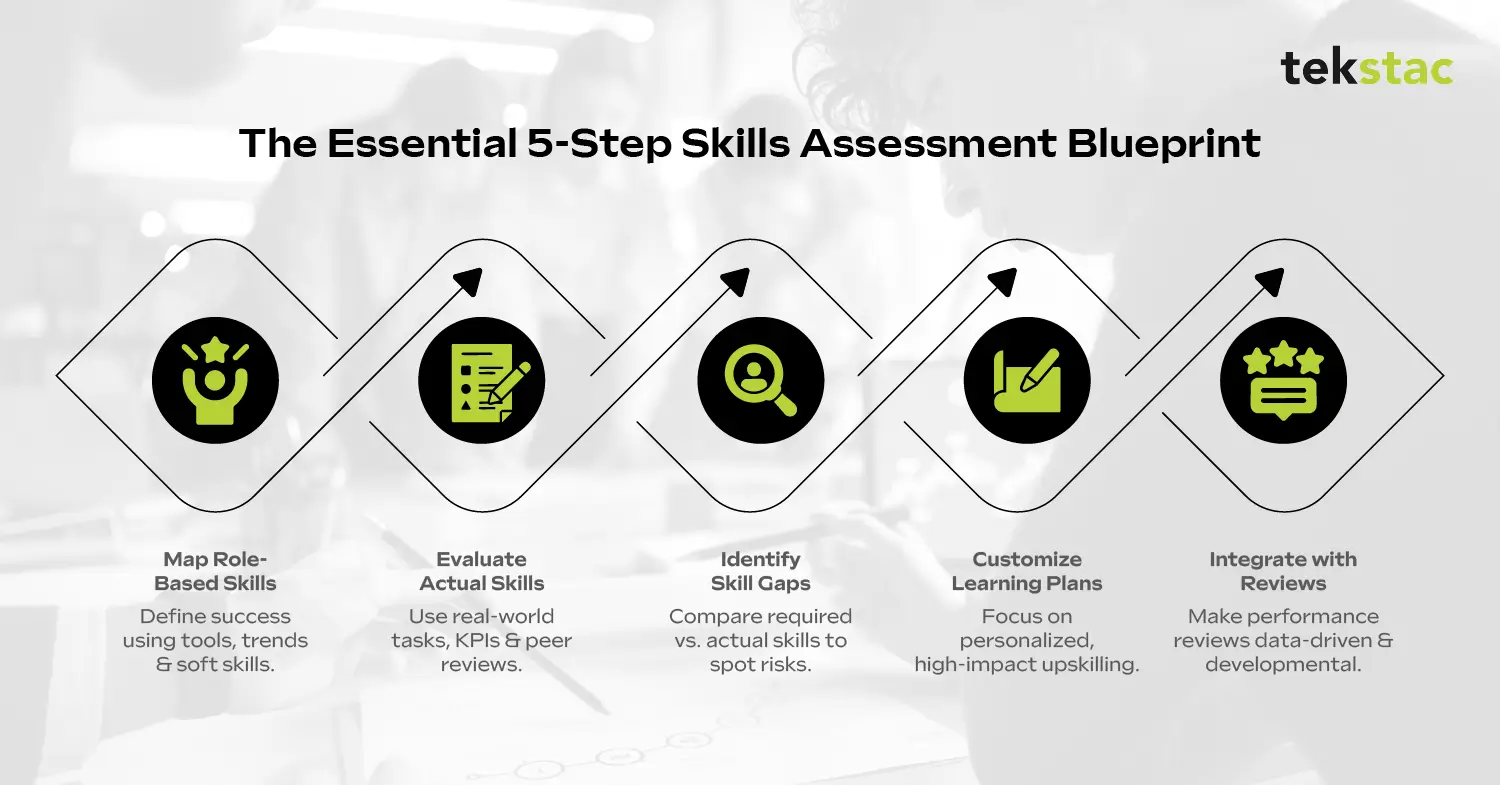
1. Map Required Skills by Role
Start by defining what success looks like in each role.
Don’t just rely on generic job descriptions. Factor in:
- Current tools and technologies
- Industry trends and compliance requirements
- Soft skills like communication or leadership
Core technical competencies tied to business impact
2. Assess Actual Skill Levels
Assessments should be performance-based, not theoretical. Combine:
- Real-world simulations (like coding tasks or client mock calls)
- Project retrospectives
- Peer reviews
- Objective KPIs
This holistic view reveals not just what someone knows—but how they apply it.
3. Conduct an Employee Skill Gap Analysis
Once both the “required” and “actual” skill levels are clear, it’s time to identify gaps.
Ask:
- What are the top skills missing from key roles?
- How wide is the gap? (scale it numerically for prioritization)
- What business risks are associated with each gap?
Tools like Tekstac offer actionable dashboards that visualize these gaps for informed planning.
4. Tailor Upskilling and Reskilling Strategies
Use the gap data to design interventions that are:
- Specific: Tied to one skill or behavior
- Personalized: Aligned to individual learning styles and levels
- Timely: Delivered as just-in-time learning or through projects
Avoid generic training modules. Go for high-impact courses, mentorship, job rotations, or AI-driven microlearning.
5. Loop It into the Employee Performance Review Process
Instead of treating Employee performance reviews as standalone rituals, integrate updated Skills Assessment data.
This:
- Makes reviews more evidence-based
- Helps managers plan career paths
- Encourages employees to take ownership of their learning journey
With this loop in place, performance management evolves into a continuous improvement system.
Real-World Case Studies: Skills Assessment in Action
1. IBM – Building a Culture of Upskilling Through Skill Assessments
IBM implements continuous skill assessments across departments. This enables:
- Real-time tracking of skills in demand
- Targeted upskilling programs
- Enhanced internal mobility for employees based on skill readiness
The result? A future-ready, agile workforce and improved employee retention.
2. Google – Precision in Tech Hiring Through Skill-Based Evaluation
Google integrates hands-on coding assessments with interviews. This dual approach:
- Ensures practical, not just theoretical, expertise
- Reduces hiring errors
- Encourages diversity by focusing on ability over background
Google’s model highlights how customized role-specific assessments lead to better hires.
3. Amazon – Scaling Skill Validation Across Thousands of Candidates
Amazon uses data-driven, scalable skill assessments in both tech and non-tech roles. Their success lies in:
- Automating assessments at scale
- Using analytics to refine test content
- Applying assessments to both hiring and internal promotions
This has streamlined their high-volume recruitment while ensuring role alignment.
The Strategic Value of Skills Assessment
By now, it’s clear: building a Skills Assessment framework isn’t just about checking boxes, it’s about creating a high-performance learning culture.
The benefits include:
- Accurate Employee skill gap analysis
- Informed employee performance reviews
- Strategic upskilling and reskilling strategies
- A boost in retention, engagement, and innovation
Choosing the Right Tools for Skills Assessment
Effective Skills Assessment isn’t just about methodology—it’s about execution. For that, you need the right platform.
An ideal tool should offer:
- Role-based assessments for accuracy
- Real-world simulations for credibility
- Analytics and benchmarks for decision-making
- Integration with LMS and HRMS for workflow continuity
One platform that delivers across these fronts is Tekstac.
Tekstac: Your Strategic Partner in Skills Assessment
Tekstac provides a comprehensive platform designed specifically for organizations aiming to execute a structured Skills Assessment strategy. Here’s how it maps directly to your needs:
Role-Based Skill Assessments
Tekstac aligns its evaluation modules with specific job functions. This means:
- A data scientist is assessed on ML proficiency, data handling, and tool familiarity
- A sales professional is tested on objection handling, CRM use, and negotiation skills
This relevance ensures accurate insights, not guesswork.
Real-World Coding Simulations
For technical roles, Tekstac provides live coding environments that simulate real business challenges. This tests:
- Logical thinking
- Clean code principles
- Time management under pressure
Automated Grading and Benchmarking
Using smart algorithms, Tekstac automates evaluations. No more manual checks. The platform also benchmarks individual performance against:
- Team averages
- Industry norms
This lets you see exactly where your talent stands competitively.
Actionable Analytics
One of the standout features of Tekstac is its data visualization engine. Leaders get:
- Clear dashboards on skill distributions
- Heat maps of critical skill gaps
- Recommendations for learning interventions
Seamless Integration with LMS/HRMS
Tekstac doesn’t replace your existing systems—it enhances them. It can plug into:
- SAP SuccessFactors
- Workday
- Moodle
- Other enterprise LMS/HRMS platforms
This ensures that Skills Assessment becomes part of your daily workflow, not an isolated event.
Addressing Common Objections to Skills Assessment
Even when leaders understand the value, adoption of a Skills Assessment system is often delayed due to concerns. Let’s tackle them head-on.
Concern 1: “It’s Too Resource-Intensive”
Reality: While the initial investment requires time and effort, the return is exponential.
- Accurate Employee skill gap analysis reduces wasted training budget
- Productivity improves as tasks align with talent
- Turnover drops when employees feel properly utilized
Think of it as building a foundation for everything: learning, staffing, innovation.
Concern 2: “Employees Will Feel Threatened”
Reality: If framed incorrectly, yes. But the key is intentional communication.
- Emphasize growth, not judgment
- Position assessments as tools for career progression
- Highlight success stories where employees unlocked new roles due to their hidden talents
You’re building a feedback-rich culture, not a punitive one.
Concern 3: “It’ll Be Outdated Fast”
Reality: This is where tools like Tekstac excel.
Their assessment libraries can be updated regularly to reflect:
- New technologies
- Regulatory changes
- Internal strategy shifts
Additionally, since assessments are data-driven, you can adapt based on live skill evolution.
Concern 4: “Integration Will Be a Nightmare”
Reality: With modern APIs, platforms like Tekstac make integration nearly frictionless.
They offer plug-and-play compatibility with popular platforms, ensuring that:
- HR teams don’t juggle multiple tools
- Employees have a seamless experience
- Data flows directly into your performance management systems
Implementing a Continuous Skills Assessment Loop
Now that tools and objections are covered, here’s a practical execution roadmap to embed Skills Assessment into your culture.
Step 1: Start With a Pilot Program
Choose a single department (e.g., engineering or sales). Use Tekstac to:
- Run a baseline skill evaluation
- Identify critical skill gaps
- Deliver personalized training based on the results
Measure outcomes (project success, engagement scores, peer feedback) to validate the ROI.
Step 2: Align Assessments with Learning Paths
Connect results directly to upskilling and reskilling strategies. Whether you use internal academies or external platforms, make sure the learning paths solve for actual, identified gaps.
Step 3: Integrate with Performance Reviews
Bring the Skills Assessment data into regular employee performance reviews.
- Use it to validate strengths
- Create development plans with measurable milestones
- Identify high-potential employees for stretch assignments or promotions
Step 4: Scale Organization-Wide
After validating with one unit, roll out across departments.
Best practice: staggered implementation with champions from each team. This improves adoption and reduces pushback.
Long-Term Benefits: Beyond Metrics
Once fully embedded, Skills Assessments become part of your company DNA. The long-term benefits include:
- Better succession planning
- Enhanced internal mobility
- More targeted hiring
- A resilient workforce capable of shifting with the market
You also create a learning culture where development is tied to real business outcomes, not just hours logged in training portals.
Final Thoughts
In a business environment, the difference between surviving and thriving lies in your workforce adaptability. A structured Skills Assessment framework is not just a tool, it’s your organization’s compass for growth, relevance, and competitive edge.
It enables you to:
- Replace guesswork with data
- Empower employees through transparency
- Align training with real business needs
- Prepare for the future, not just react to the present
Tekstac offers a powerful, customizable engine to help you implement this vision, from employee skill gap analysis to role-specific learning. The time to move from assumptions to action is now.
A Practical Guide to Using the ADDIE Model for Talent Development
Almost half of the skills possessed by the present workforce is likely to become outdated in a mere two years.
Now, organizations have a challenge: “How do we continuously build talent in order to catch up with technological advancements?”
Most organizations tend to respond to skill shortages only after they have significantly affected performance, causing expensive delays. There’s a need for a disciplined, systematic approach to talent development that deals with business needs as they occur but also prepares for future requirements.
The ADDIE model provides a framework to design such learning programs. In this blog, let’s discuss in-depth how this model functions and how you too can apply ADDIE to talent development in 2025.
What Is the ADDIE Model and Why It Matters in 2025
The ADDIE model is a five-step process for designing and implementing learning programs. It is an acronym for Analyze, Design, Develop, Implement, and Evaluate, representing five unique phases that walk you through from recognizing a learning need to measuring its business consequence.
The World Economic Forum reckons that 40% of the most important skills needed in the labour market will shift because of AI, automation, and evolving job roles by 2030. Meanwhile, L&D budgets are increasing, as 85% of employers intend to implement upskilling approaches between 2025–2030. This goes on to explain that organizations are betting heavily on talent development but require established, systematic models such as ADDIE that ensure desired results.
Applying the ADDIE Model: A Practical Phase-by-Phase Breakdown
In the ADDIE model, each step forms the building block for the subsequent step, making a pathway from business needs identification to the delivery of effective learning solutions.
Make sure not to skip any stage, as the whole process gets compromised. For instance, if you don’t examine the correct problem, your training and development program will be off the target, and you will end up with training that fails to address performance gaps. This also results in wasted resources, unmotivated learners, and no measurable effect. Any workforce upskilling method must follow a structured approach to be effective.
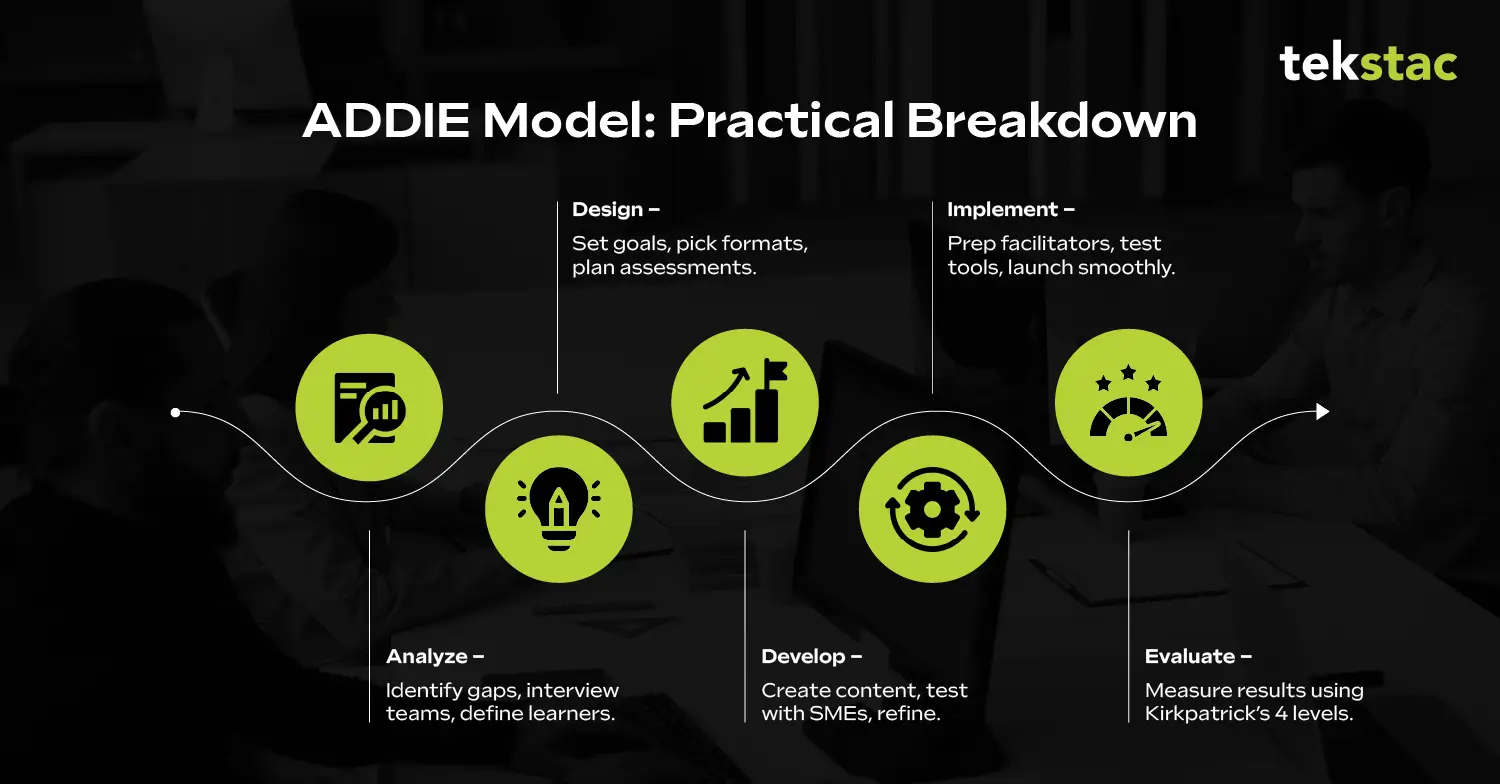
Here’s a practical phase-by-phase ADDIE model breakdown so you can implement practically:
Phase 1: Analyze
Before you build anything, you need to know what business problem your learning program is solving. The Analyze phase anchors your learning intervention to a real-world business problem. It pinpoints the exact performance gap your employees face and why it exists. In other words, you’re diagnosing a business problem that learning might help fix.
In most organizations, performance gaps show up subtly. Whatever the case, the problem is always reflected in business metrics: attrition, ramp-up time, NPS, conversion, quality scores, and so on. This phase helps you trace those symptoms to specific skills, behaviors, or knowledge gaps.
Start with the business problem: The first step is identifying the problem. This step aims to understand why performance is lagging and whether a learning intervention is the right response. The more straightforward your diagnosis, the more focused and effective your solution will be.
- Review recent business KPIs to spot underperformance
- Identify departments or teams where output has dipped or errors have increased
- Interview managers to surface recurring workflow or behavioral issues
- Map any recent process, policy, or structural changes that may have caused confusion
- Write a 1-2 sentence problem statement defining the gap
Talk to stakeholders: Interview stakeholders, such as managers, high performers, underperformers, and cross-functional teams to identify the challenges and behaviors that are causing the issue.
- Interview managers and employees across levels
- Ask where people struggle most and what behaviors impact success
- Explore recent tool, process, or team changes causing friction
- Identify what people currently do to solve challenges, and what’s missing
Understand who you’re designing for: Consider your audience’s real work context. Consider their roles, daily challenges, tools, and learning preferences. Create a simple learner profile that highlights their pain points and blockers.
Phase 2: Design
This stage transforms the findings gathered in Phase 1 into a roadmap that directs the creation of training and development materials. The intention here is to develop an elaborate map that links learning outcomes to changes in behavior and measurable business outcomes. Prepare yourself for providing answers to questions such as:
- What specific learning objectives will close the performance gap?
- Which instructional strategies and formats will engage your learners?
- How will you sequence the content for maximum impact?
- What assessment methods will confirm learners are applying new skills effectively?
Define clear learning objectives: Start by crafting your business problem into well-articulated, measurable learning goals. These need to be precise, actionable, and geared toward behavior or skills that have a direct influence on performance.
- Write objectives that answer: “What should learners be able to do differently after training?”
- Use action verbs (e.g., demonstrate, apply, analyze) to ensure clarity
- Align objectives with the desired business outcome defined in Phase 1
Choose the right learning strategies and formats: Select instructional methods that fit the audience’s preferences, context, and learning goals. Look at microlearning strategies, application based learning, workshops, simulations, or blending learning. Consider accessibility, time constraints, and resource availability. Make sure to sequence learning to progress smoothly from foundational knowledge to mastery along with practical applications.
Plan assessment and success metrics: Design formative assessments to reinforce learning during the program and plan summative assessments to validate skill adoption at the end. Ensure to align assessment criteria with business success metrics established earlier.
Phase 3: Develop
The development phase is where your learning solution comes to life. In this production stage, you create and assemble all training materials. This demands collaboration to ensure content quality, relevance, and consistency with learning objectives. It’s also the time to integrate tools and technology that will help deliver the program smoothly. Build drafts, test them internally, gather feedback, and refine them before launch. This cycle helps catch gaps early.
- Ensure every material directly supports your defined objectives and reflects real learner challenges
- Engage subject-matter experts early on to review and validate the quality and applicability of your content
- Add examples and anecdotes that connect with learners’ everyday activities
- Plan frequent check-ins and leverage collaborative tools to track versions, feedback, and approvals easily
- Run soft launches, collect structured feedback through surveys or interviews, and refine content
Phase 4: Implement
After your learning materials are refined and approved, it’s time to implement the learning program in real life. This step guarantees the training launch is smooth and that learners can interact optimally. Therefore, it calls for extensive planning and coordination to prevent glitches
Prepare trainers and facilitators: Provide thorough briefings, detailed facilitator guides, and rehearsals if needed.
Set up the learning environment: Ensure that your LMS, virtual classroom, or physical space is fully prepared before launch. Test all technical elements, including access, multimedia playback, and interactive tools. Confirm that learners have the right permissions and resources.
Communicate early with learners: Share program objectives, schedules, and how learners can access materials or sessions. Provide clear instructions and support contacts for any technical or content questions.
Phase 5: Evaluate
Evaluation is the vital last step in the ADDIE model, where you compare the success of your learning program against initial objectives. This step makes sure you are aware of the influence on the learner performance as well as the larger business goals. Without evaluation, all your work may be wasted or incorrect.
You need to assess whether learners have acquired the intended skills or knowledge and, more importantly, if their behavior or performance has improved on the job. This data guides future iterations and helps justify training investments. Use a combination of quantitative and qualitative methods to gather comprehensive insights. Look beyond immediate reactions and track long-term changes wherever possible.
Focus on multiple levels of evaluation: Kirkpatrick’s model is a proven framework here:
- Level 1: Reaction: Did learners find the training relevant and engaging?
- Level 2: Learning: Did they absorb the content and develop the skills?
- Level 3: Behavior: Are they applying what they learned on the job?
- Level 4: Results: Is the business seeing measurable improvements tied to training?
Collect data methodically: Use surveys, quizzes, interviews, performance metrics, and observation to collect data. Evaluate at multiple points, such as immediately post-training, 30 days after, and ideally after 90 days to track sustained impact.
Keep in mind that Phase 5 is not a one-time activity. Use your findings to identify gaps, refine content, enhance delivery, and scale successful elements.
Real Example of ADDIE in Talent Development
Here is one company that successfully implemented the ADDIE model for talent development:
IBM
In the late 1990s, IBM felt a vanishing sense of leadership readiness. The business diversified across borders and business units, yet first-line managers were unprepared. The transition from individual contributor to leader was shaky, and managers lacked a shared understanding of good leadership. That’s when IBM rolled up its sleeves and brought in an old and sharp framework, the ADDIE model, turning it into its own Basic Blue training program. The fourth tier of the program was defined as the Evaluation phase of ADDIE.
Analyze: IBM recognized that first-line managers were unprepared for leadership roles. Too often, they emerged from individual contributor roles lacking key managerial skills. Their audit revealed critical gaps in delegation, feedback, and team management.
Design: IBM designed Basic Blue as a 4-tier e-learning blended program, with three online tiers being articles, simulations, and job aids. This was followed by a final in-person “Learning Lab” classroom session.
Develop: IBM produced multimedia-rich content, Manager QuickViews (editable Q&A databases), and simulations.
Implement: Basic Blue was delivered globally. First, online tiers were completed, followed by a week-long classroom experience. Completing digital tiers was mandatory before attending the Learning Lab.
Evaluate: IBM measured performance impact by identifying outcomes like better team management.
Ultimately, based on its early deployment, IBM achieved an ROI of 2,284% in 2001. After launching Basic Blue in 2000, IBM also generated $16 million in savings, and broader e‑learning programs saved $200 million that same year.
Embedding the ADDIE Framework into Your Talent Strategy
At the heart of every successful talent development strategy lies one core truth: structure. Just like IBM followed a clear, methodical framework when designing its Basic Blue program, every organization must begin with a solid foundation. This involves identifying skill gaps, structuring focused learning interventions, and ultimately putting in place mechanisms for monitoring and measuring impact.
Having a proper system, like Tekstac, is essential for L&D teams, especially those managing tech teams. Leading enterprises like IBM, PwC, and Accenture have embraced Tekstac to add more content and build repeatable, scalable, and trackable capability-building programs.
With the features below, Tekstac empowers HR and L&D teams to run talent development initiatives confidently at scale.
- Real-time skill gap analytics
- Immersive, hands-on labs
- Automated assessments
- Detailed progress tracking
To begin your personalized learning journey that stays aligned with organizational goals, explore how Tekstac can help.
How to Measure the ROI of Employee Training Programs
Companies are investing more than ever in employee learning and development. Yet, for many HR and L&D teams, answering a basic question remains frustrating, “Is it working?”
Despite billions of dollars spent on upskilling and training each year, 61% of training leaders still do not measure the ROI of their training programs. Even when employee training outcomes are measured, they’re often reduced to surface-level metrics, such as completion rates, smiley-face surveys, or test scores. While these are useful, they are neither sufficient nor adequate.
Many organizations cite lack of clear goals, insufficient resources, and uncertainty about where to start as the top challenges in measuring training ROI.
7 Steps to Measure the ROI of Employee Training Programs
Let’s take a realistic approach and a practical step-by-step process that covers actual training costs, integration with business goals, and how to use the data you already have.
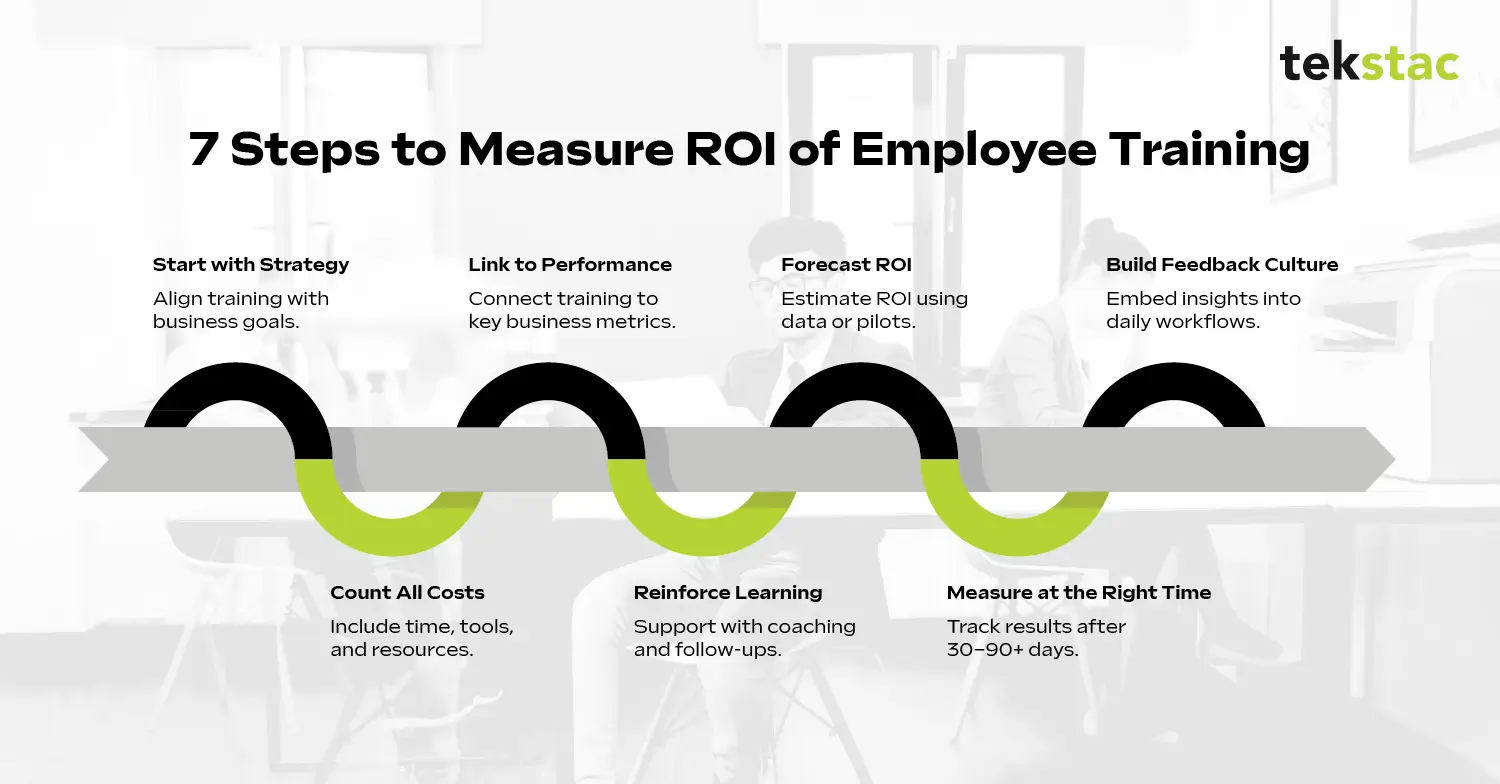
1. Start with strategic intent, not skill gaps
Most organizations begin their workplace training by identifying skill gaps, those missing competencies or technical skills employees lack. Focusing solely on skill gaps is a limited view that misses alignment with the company’s broader strategic goals and outcomes.
If L&D efforts fail to connect to what the business is trying to achieve, measuring learning impact becomes ineffective. Hence, without this strategic intent, most organizations fall prey to measuring ineffective ROI metrics like course completions or quiz scores but not outcomes such as increased revenue, improved customer satisfaction, faster product launches, etc.
To do this practically, begin every training program with a conversation beyond HR or L&D. Bring in stakeholders from business units, operations, sales, and leadership. Ask questions like:
- What are our top three business challenges this quarter or year?
- What behaviors or capabilities need to shift to meet those challenges?
- How will we know if those shifts happen?
From there, create learning objectives that tie directly to these priorities. This sets the foundation for meaningful ROI measurement. Determining learning success through business KPIs rather than just learning KPIs allows you to identify the right metrics upfront.
For example, instead of “improve negotiation skills,” a strategic intent might be to “reduce average sales cycle time by 15% through improved negotiation.”
2. Calculate the actual cost of training
Training budgets are generally calculated based on platform licenses, facilitator fees, or travel expenses. However, this approach does not capture the full cost of ownership of workplace training programs. Here’s how to ensure a more accurate cost baseline:
Employee time: Every hour spent in training is not spent on other productive work. This opportunity costs scales quickly across large cohorts.
Manager involvement: This includes conducting follow-ups, assigning pre-work, or leading on-the-job practice sessions, as they dedicate time and energy that needs to be accounted for.
Post-training reinforcement: Job aids, nudges, simulations, or coaching continues long after completing a course.
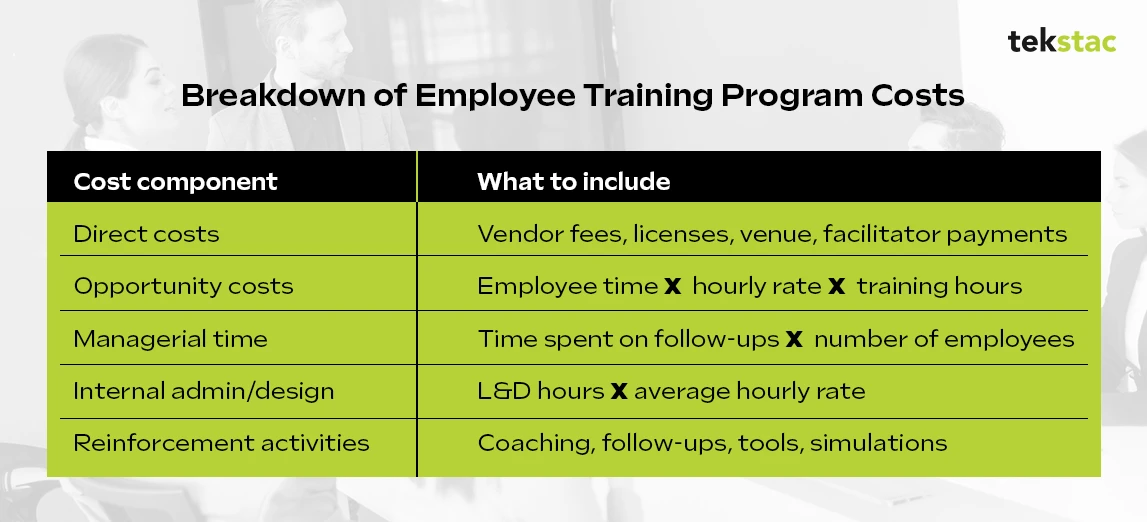
Many companies hesitate to investigate these costs out of fear they’ll seem too high, but being honest about the real cost of training actually strengthens credibility when showing impact, as leaders need an accurate number rather than a lower one.
3. Integrate training metrics with performance data
Connect training outcomes with relevant performance data, sales figures, error reduction, customer satisfaction scores, or productivity rates. Start by identifying which business metrics your training will influence, then collaborate with data owners in departments like sales, customer success, or operations. They often track these metrics regularly and can provide historical data for comparison.
Now, create a simple data dashboard or report that overlays training participation data with these business KPIs over time. Look for patterns like improvements in key metrics following the training rollout—segment data by employee groups who took the training versus those who didn’t to isolate the impact.
For example, if average sales increase by 10% post-training in your trained group compared to untrained peers, that’s a clear signal of positive ROI. You can then translate that uplift into dollar values for your ROI formula.
4. Reinforce training or watch it decay
Some employee training programs fail because of what happens after the session ends. Per the Forgetting Curve concept, 90% of learning is forgotten within a week if not reinforced. As we observe, most L&D programs still operate on a “one-and-done” model.
Training is not a single event; it’s a process of behavioral change. Without reinforcement, there’s no lasting change, hence no real ROI. This means measuring training ROI must include structured reinforcement. Here’s what to include:
- Manager-led debriefs
- Microlearning nudges
- Job aids and checklists
- Peer sharing sessions
- Follow-up assessments
Tip: When planning your program, allocate at least 20-30% of your training budget or timeline to reinforcement.
A simple way to measure ROI with reinforcement in place would be to use this formula:
ROI of training programs (%) = (Total Benefit – Total Cost)/Total Cost x 100
Let’s break this down:
Total benefit = Business gains because of the training (e.g., time saved, revenue increased, increase in resolution times, etc.)
Total cost = Training costs + time + reinforcement tools or coaching
5. Predict ROI
Predicting ROI upfront helps align expectations and secure stakeholder buy-in. Many organizations skip this step, making it harder to justify investments or set realistic goals. You can estimate the potential business impact your training can have based on historical data, benchmarks, or pilot programs. Forecast the costs involved so you have a clear picture of the investment
Predicted ROI (%) = (Expected Benefit – Cost)/Cost x 100
You can use smaller pilot groups to test training impact quickly before wider rollout and gather early performance signals, like knowledge application or behavior change, to adjust predictions. While predictive ROI isn’t perfect, it sets a proactive foundation for tracking and optimizing training success.
6. Time your ROI measurement
Measuring ROI too soon can be the biggest trap. True business impact from training often takes time to materialize. Behavior changes, productivity gains, or revenue improvements rarely appear overnight. It’s important to recognize that a training program might initially show a negative ROI or no measurable benefit—not because it failed, but because you haven’t yet reached the break-even point where benefits outweigh costs. To measure employee training ROI right:
- Set realistic evaluation windows (30,60,90 days or 6 months) based on training type.
- Assess learner engagement, knowledge retention, and behavior changes soon after training.
- Measure key business outcomes like sales performance, error rates, or customer satisfaction over a longer period.
- Regularly assess ROI to track progress over time and capture delayed benefits.
If, after the appropriate measurement window, ROI remains negative, don’t see it as a failure but as a sign to dig deeper. It could mean the training wasn’t aligned with business priorities, the delivery method ineffective, or the benefits are harder to quantify. Use this insight to reassess training goals, refine the training content, improve reinforcement strategies, or adjust your metrics.
7. Embed cultural insight and continuous feedback for sustainable ROI
Training effectiveness depends heavily on how well it aligns with organizational culture, leadership support, and employee readiness to change. If the culture resists new behaviors or lacks reinforcement mechanisms, ROI will suffer despite great content or delivery. Factors like peer influence, manager involvement, and workplace norms shape whether learning turns into performance improvements.
Create channels to collect feedback not only immediately after training but throughout the learning journey. This includes:
- Regular pulse surveys on behavior change
- Manager check-ins for skill application
- Performance data reviews to spot trends and gaps
- Open forums or focus groups for qualitative insights
The key here is to partner with managers to embed learning checkpoints into regular workflows, leverage technology platforms that allow real-time feedback and data integration, and communicating changes periodically.
Want practical strategies and future trends in employee development?
👉 Explore more in our full blog.
Next training program coming up? Time to lock in the ROI
To actually measure training impact, the preparation work starts much earlier, with how you design your training ecosystem. There’s a need for a tool that not only delivers content but effectively tracks, connects, and analyzes every learning touchpoint against actual business KPIs.
Tekstac’s learning analytics and management modules help perfectly:
- Leverage custom dashboards with real-time progress tracking and KPI overlays
- Anticipate outcomes before full rollout with our predictive analytics
- Track every input and output with talent supply chain view
- Align skilling with future business needs with skill inventory monitoring
- Simplify insights for business leaders with custom reports
The platform also powers your learning experience with custom learning paths, mentor marketplace, virtual sessions, auto-evaluated practice labs, AI-proctored assessments, and many more. With over 1 million professionals upskilled, 24 million+ learning hours, and enterprise customers like IBM, PwC, Capgemini, and Cognizant, Tekstac is built for organizations that want to transform how they train and upskill. See Tekstac in action.
How to Integrate AI and Automation in Talent Development Programs
The world of work isn’t just changing; it’s evolving faster than most companies can keep up. What used to work ten years ago, scheduled training sessions, fixed job descriptions, manual performance reviews, is now dangerously outdated.
In this environment, a business is only as strong as the adaptability of its people.
This is where Talent Development Programs come into the picture. These aren’t just employee workshops or onboarding checklists anymore. They are enterprise engines.
Engines that build skill, enhance judgement, and turn employees into contributors capable of facing the unknown with confidence.
According to a 2025 McKinsey report, 60% of executives now say their company’s competitive edge depends on how quickly they can reskill their people.
That’s not HR fluff.
That’s a strategic priority for business growth.
And yet, most organizations are still treating talent development like a cost center, not the profit multiplier it actually is.
The real problem is that training is still reactive. It’s not aligned to the job. It’s not intelligent. And in many cases, it’s not even reaching the right people at the right time.
That’s why businesses lose talent, productivity, and in the long run, relevance.
What Smart Talent Development Unlocks
There’s a better way. One that treats talent like a living system, not a static resource. The new standard for Talent Development Programs is adaptability.
Not just what employees know, but how quickly they can learn something new when the rules change.
This is where AI in learning and development becomes mission-critical. AI/ML based HRTech tools now enable companies to tailor learning paths for each individual, not just based on their role, but on performance patterns, their career aspirations, business requirements, learning style, and growth trajectory.
Take a look at what this unlocks
- Personalized learning delivered at the moment of need
- Real-time skill gaps analysis
- Auto-curated content libraries based on job performance
- Virtual mentors that provide 24/7 feedback and coaching
In a recent LinkedIn Workplace Learning report, companies that invested in AI-enabled talent development platforms reported a 23% increase in internal mobility and a 30% reduction in turnover.
That’s how powerful smart development can be.
And don’t ignore Upskilling through automation. When machines handle repetitive tasks, human workers must step into higher-order thinking roles, negotiation, decision-making, leadership. But they can only do that if they have the necessary skills.
When Companies Do It Right
Let’s break this down through a practical lens.
Unilever, one of the world’s top consumer brands, completely reshaped its approach to talent development by dismantling traditional roles and replacing them with task-based assessments.
Instead of promoting based on time served, employees were assessed based on project complexity, agility, and learning speed.
With AI embedded in its learning system, Unilever enabled every employee to build their own career map, automatically updated based on skill growth and business needs.
This shift didn’t just improve retention, it unlocked hidden talent across the entire organization.
Or consider Genpact, a global services company. When GenAI exploded onto the scene, they immediately created AI-driven employee development tracks focused on prompt engineering and LLM literacy.
Over 75,000 employees completed their AI foundation module in under 6 months, leading to a 3x increase in total learning hours over the past four years.
These aren’t edge cases. They’re the new standard.
The Pillars of Future-Ready Talent Development Programs
Now here’s what every business needs to start doing immediately
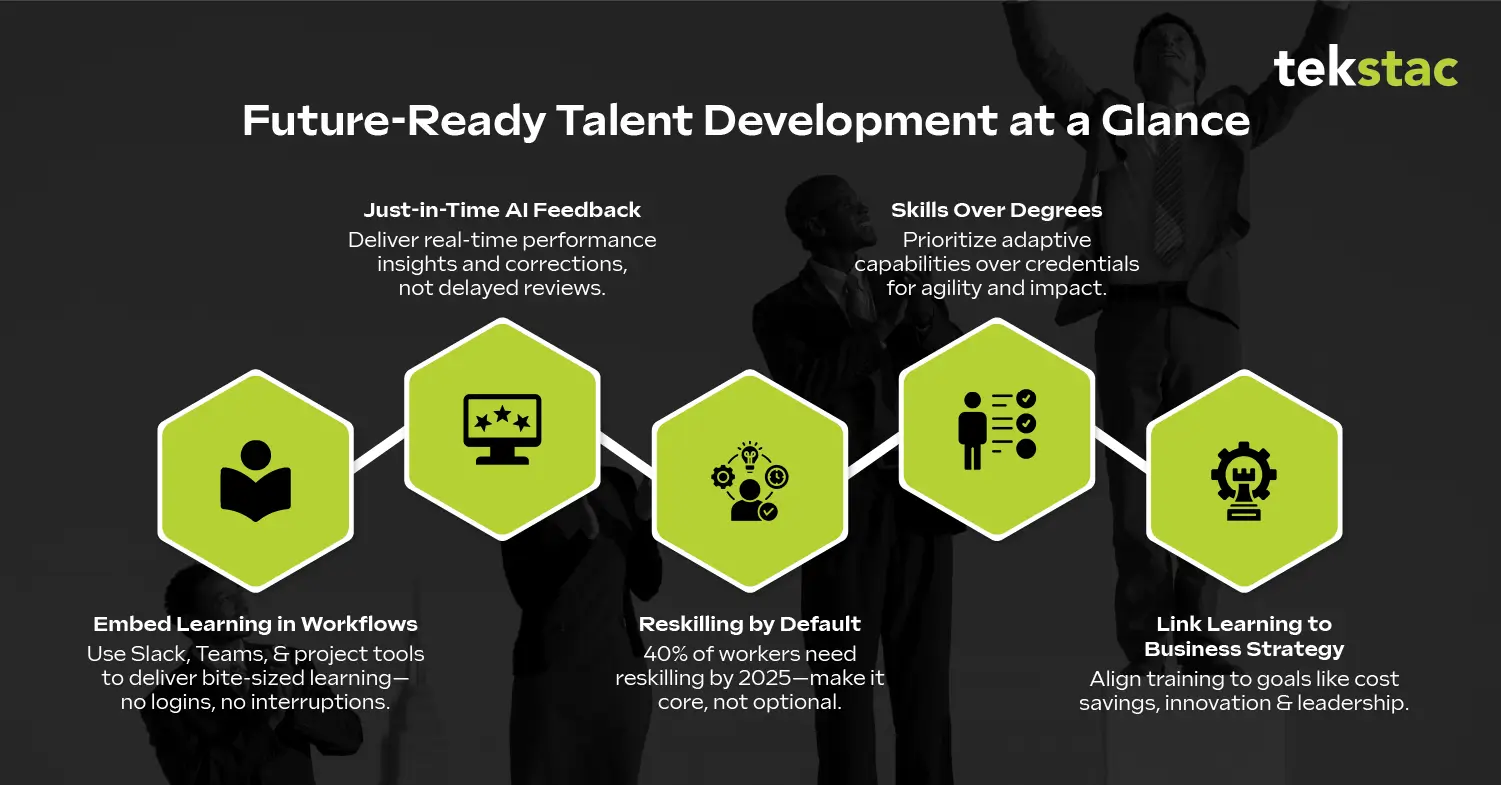
1. Build Learning into the Flow of Work
People won’t engage in training if it interrupts their work. That’s why modern Talent Development Programs embed learning into tools already being used — Slack, Teams, project management software. Microlearning modules triggered by real work tasks.
No separate login.
No off-site seminar.
2. Use AI to Deliver Just-in-Time Feedback
Learning must happen when it matters most. With AI in learning and development, systems can now evaluate an employee’s real-time performance, detect errors or gaps, and offer corrective content instantly.
No need to wait for the next quarterly review.
3. Make Reskilling a Default, Not a Perk
A 2025 World Economic Forum study found that over 40% of all workers will need reskilling within the next three years.
That means Upskilling through automation isn’t a nice-to-have. It’s a survival plan. Companies must fund, incentivize, and promote reskilling pathways by default.
4. Shift Focus from Degrees to Skills
Credentials are no longer the main currency of value. The ability to adapt, learn, and apply new knowledge rapidly is what counts. AI systems can assess these traits better than any traditional resume scan.
A recent SAP SuccessFactors case study showed that companies adopting skill-first development models saw a 26% increase in project delivery speed and a 15% improvement in leadership pipeline efficiency.
5. Map Development to Business Strategy
This is where too many get it wrong. Learning is treated as an HR metric, not a revenue enabler. True AI-driven employee development maps every learning track to a clear business objective — cost reduction, faster innovation, customer satisfaction, leadership capacity. Training must be an investment that pays back.
The Strategic Advantage Hidden in Plain Sight
Every company is sitting on a goldmine. Their people. But talent without development is just potential, not performance. The companies that win in this next decade won’t be the ones with the most capital, but the ones with the most adaptable workforce.
Talent Development Programs are no longer optional. They are the core infrastructure. As critical as cloud servers or cybersecurity. And when powered by AI, they don’t just train workers. They evolve them.
The time to act is now. The longer the delay, the wider the skills gap becomes.
And here’s the truth. Implementing this doesn’t have to be hard. Not with the right partner. There are platforms today that can deploy these capabilities out of the box — from smart learning paths to performance-linked coaching to skill analytics that make HR feel like strategy.
Let Intelligence Lead the Way Forward
It’s a different game now.
Static roles have been replaced by skill clusters. One-size-fits-all training is obsolete.
And AI isn’t just automating tasks — it’s building talent.
There’s no turning back. The choice for organizations is simple.
Keep relying on outdated training systems, lose people, fall behind.
Or, switch to intelligent, data-driven, personalized development and build a workforce ready for anything.
Unlock the Future of Talent Development
If there’s one place to start, it’s with a smart platform that aligns learning, performance, and business goals.
One that offers everything from skill taxonomies to AI-powered coaching, from role-based content curation to real-time feedback — all personalized, scalable, and integrated
Try Tekstac today and experience what intelligent talent growth can really look like
👉Get Started Now
7 Proven Workforce Development Strategies to Implement in 2025
Why Most Workforce Development Strategies Fail
If more than 90% of employees say they’d stay longer at a company that invests in their career, why are so many still leaving?
The answer is simple. Most workforce development strategies are not working. They’re well-intentioned, but too generic, reactive, or completely disconnected from what employees need to grow—and what the business needs.
Organizations are spending time and money on learning initiatives. Over half of them list upskilling and reskilling as a top priority. However, only 21% believe their efforts are practical. While this internal pressure causes misalignment, external pressure is mounting.
With AI and automation expected to disrupt nearly half of all jobs in the coming years, most organizations still lack access to the right resources.
This is the gap companies need to close, and in this blog, we’ll discuss exactly how, with the most effective employee upskilling strategies.
What Makes a Good Workforce Development Strategy?
If we look at the root cause of most ineffective workforce development strategies, we find they’re performative. A few courses here, a new platform there, perhaps some annual compliance training—they rarely drive any change on the ground.
In 2025, a good workforce development strategy is built with intention. Let’s see how.

1. It’s centered on future skills, not just “more” skills
Just because employees are learning something doesn’t mean it’s moving the needle. A solid strategy focuses on the adoption and practical use of future-forward skills. The goal isn’t to train for training’s sake. It’s to ensure your workforce is equipped for the shifts across your industry.
2. It prioritizes purposeful, personalized learning
Throwing generic content at employees and hoping it sticks is not a strategy. A meaningful employee upskilling strategy personalizes learning to the employee’s role, growth path, and learning style, while ensuring every resource serves a clear purpose. Whether self-paced modules, peer mentoring, or live sessions, every touchpoint should move the learner (and the business) forward.
3. It connects directly to business outcomes
Learning in isolation won’t drive results. The strongest strategies are mapped directly to business goals: increasing customer satisfaction, enabling digital transformation, or closing leadership gaps.
As always, a good employee development strategy must be measurable. If you can’t track skill development, impact, and progress, you’re just guessing. Additionally, development shouldn’t be a separate activity employees do when they “find the time.” The best strategies are embedded into everyday workflows through feedback, real projects, coaching, and collaboration.
Top Workforce Development Strategies for 2025
As we often notice, some development strategies die quietly after a while, even after allocating training budgets or launching an LMS. If you’re wondering why nothing’s changing on the floor or if you want to take a more innovative approach to workforce development, below are the top 7 workforce development strategies.
1. Future-Back Skill Planning
If your workforce development strategy starts with you looking at current roles and asking, “What’s missing?” you’re already going backward. The smarter question is, “What roles and skills will we need in two years—and how do we build for that now?” Future-back skill planning starts with forecasting future capabilities based on business goals, market shifts, and industry evolution. It requires a partnership between HR, L&D, and leadership to identify skill adjacencies, define learning paths, and bake them into career journeys.
2. Build Company-Wide AI Literacy
With the rise of AI, most companies are excited to invest in GenAI or piloting chatbots. However, employees may still be unaware how exactly it embeds into their work. For example, does your payroll team know how AI affects them? Does your customer service team understand how it’ll change how they work?
AI literacy can’t be just for the IT crowd or the early adopters. Everyone in your company needs to know what AI means for their job — what it automates, what it makes easier, and what it demands from them now.
3. Create Personalized Learning Funnels
Most learning strategies assume people are all starting from the same point, learning in the same way, and aiming for the same goal. This usually ends up in choosing a same course or a learning platform that leave high performers bored and struggling folks overwhelmed.
A better approach would be to build learning journeys like real paths based on where someone actually is, rather than assuming where the employee stands, knows, or wants to go.
4. Make Career Growth Predictable
Ask people how to grow in their company, and most will shrug. Very few know what leads to a promotion or a role switch. This is a big problem. Career paths are usually vague, unspoken, or left to chance. And when there’s no clarity, the same types of people keep getting promoted while others get stuck.
Make growth feel intentional. Start by mapping out what success looks like in each role. Be specific. What skills, outcomes, and behaviors are needed to level up? Don’t keep it locked in a PDF either, bring it into everyday conversations. Managers should reference these paths in check-ins.
5. Use Immersive Learning to Close the Practice Gap
Some traditional L&D strategies run like a school timetable, involving annual plans, quarterly workshops, and calendars. But work doesn’t wait for Q3 to teach you something. It throws new tools, priorities, and challenges at you out of nowhere. When learning doesn’t show up in those moments, people either wing it or stall.
A better way would be to make learning immediate by using microlearning. If someone’s stepping into a new project, give them a quick how-to guide right then. Learning has to move at the speed of change. Otherwise, it’s already too late.
6. Measure Whether People Got Better
Solely looking at whether the employee has completed the course doesn’t help determine if they learned anything. Hence, measure impact. If someone took a negotiation course, are they actually closing deals better? If they were trained on giving feedback, is their team communicating more clearly? Tie learning to actual outcomes — better performance, fewer errors, stronger collaboration.
7. Make Development a Shared Ownership
As we often notice, workforce development gets boxed into L&D or HR. However, real growth happens in the flow of work, driven by managers, shaped by teams, owned by employees. That shift only happens when everyone sees development as their job. Give employees visibility into skill paths. Equip managers to enable growth, not just review it. And get leaders to invest in learning as a lever for business impact. Ultimately, when employee development becomes a shared ownership, it scales.
Empowering Managers to Focus on Strategic Leadership
In many organizations, managers are expected to drive both project outcomes and team development. However, without the right tools, they often struggle to provide consistent, personalized growth opportunities for their teams. This gap can lead to disengagement and high turnover.
The right tools, like Tekstac, address this challenge by offering an AI-powered, end-to-end skilling platform that automates and personalizes the learning journey for each employee. With over 500+ curated learning paths covering in-demand tech areas like data analytics, cloud computing, and cybersecurity, Tekstac ensures that employees have access to relevant, up-to-date content.
The platform’s integrated lab environment enables real-time, hands-on practice across various technologies, allowing employees to apply new skills in a controlled setting. Additionally, AI-driven personalization analyzes skill assessments to identify knowledge gaps and recommends tailored learning paths aligned with individual career goals.
Additionally, for managers, Tekstac provides real-time insights into team progress through intuitive dashboards and analytics. This visibility allows managers to track development, plan interventions, and make informed decisions without micromanaging the learning process.
Ultimately, managers and organizations can focus on strategic leadership and team engagement, confident that their teams are progressing along personalized, goal-oriented learning paths.
Want to dive deeper into how L&D is transforming? Read our full guide on The Future of Employee Training and Development for insights and next steps.
How Tekstac Skills Assessments Improve Learning Outcomes and Drive ROI
“If you can’t measure it, you can’t improve it.” This simple truth is the foundation of modern learning and development strategies. As organizations channel time, effort, and resources into upskilling and reskilling their people, the focus has decisively shifted from activity to impact. It is no longer enough to know that a course was completed, or a training was attended; stakeholders want to understand what the learner gained. This is where Learning Outcomes come into play.
What Are Learning Outcomes? Definition & Importance
Learning outcomes are the specific skills, knowledge, attitudes, and competencies that a learner is expected to acquire as a result of a learning experience. Unlike learning objectives, which describe what the instructor aims to teach, learning outcomes describe what the learner can do after the training. These outcomes are measurable and actionable, making them essential for evaluating learning effectiveness.
Examples of learning outcomes include:
- A marketing executive being able to analyze customer segmentation data.
- A programmer demonstrating secure coding practices.
- A manager applying emotional intelligence in team interactions.
Why Measuring Learning Outcomes Matters for Organizations
Organizations invest millions in learning and development each year. But without concrete measurement, these initiatives risk becoming superficial. Here are some key reasons why measuring learning outcomes is critical:
1. Validates Learning Effectiveness
Measuring outcomes helps determine whether a training initiative led to improved skills or behavior change. This validation ensures that learning is meaningful, not just procedural.
2. Enables Personalization and Continuous Improvement
Assessment of learning outcomes helps identify skill gaps, enabling personalized learning paths. For instance, if a learner struggles with a certain concept, targeted content or support can be introduced. Over time, this leads to continuous improvement in both learning content and learner performance.
3. Aligns Learning with Business Goals
When learning outcomes are tied to business objectives (like improved customer satisfaction, increased productivity, or reduced error rates), it creates alignment between individual development and organizational success.
4. Drives Accountability
In today’s data-driven world, L&D departments are increasingly accountable for delivering measurable results. Outcomes-based measurement offers transparency and builds credibility with stakeholders.
5. Informs ROI Calculations
You can’t demonstrate ROI without data. Measuring learning outcomes provides the metrics needed to correlate learning interventions with business impact, making it possible to justify or even expand the L&D budget.
The Shift Toward Data-Driven Learning Outcomes Measurement
Traditional learning measurement methods, such as tracking attendance and course completion, are giving way to more sophisticated, data-rich approaches. Organizations now leverage data analytics to capture granular insights into learner performance, progression, and engagement.
This shift is fueled by the increasing availability of digital learning platforms and AI-driven tools that collect, process, and analyze learning behavior in real-time. Predictive analytics, adaptive assessments, and learning experience platforms (LXPs) are transforming how we measure success. By using data to continuously evaluate and refine learning interventions, organizations ensure that every learning dollar is spent strategically.
According to a Deloitte survey, 61% of high-performing organizations use data analytics to support learning strategy development- more than double the rate of their lower-performing peers.
How Learning Outcomes Connect to Business ROI
The ultimate goal of measuring learning outcomes is to prove—and improve—return on investment (ROI). Here’s how outcomes data directly impacts ROI:
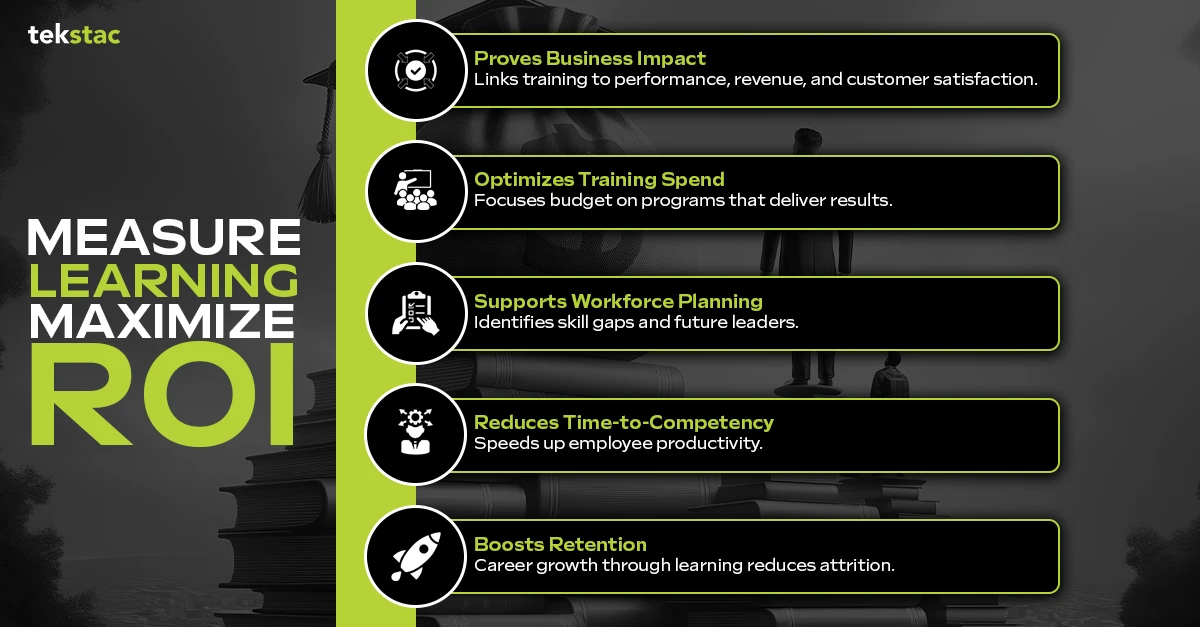
1. Demonstrating Business Impact
Clear outcomes link learning efforts to key business metrics such as employee performance, customer satisfaction, and innovation speed. For example, improved sales training outcomes can be measured against increased revenue or shorter sales cycles.
2. Optimizing Training Spend
Outcome data helps identify high- and low-performing programs, enabling better budget allocation. By cutting ineffective initiatives and scaling successful ones, organizations maximize learning ROI.
3. Supporting Workforce Planning
By measuring outcomes, organizations can identify future leaders, skill shortages, and team strengths. This enables proactive talent management and succession planning.
4. Reducing Time-to-Competency
Effective training backed by measurable outcomes shortens the time it takes for employees to reach full productivity, accelerating ROI.
5. Boosting Employee Retention and Engagement
Employees who see real career progression through skill development are more engaged and less likely to leave, significantly reducing attrition costs.
Modern Methods to Measure Learning Outcomes Effectively
Many organizations still rely on traditional methods like attendance tracking, course completion rates, or post-training feedback forms. While useful for gauging engagement or satisfaction, these methods do not assess skill application or knowledge retention.
Modern approaches include:
- Formative and summative assessments: Conducted before, during, and after learning to evaluate comprehension.
- Simulation-based assessments: Providing real-world scenarios to test applied skills.
- Project-based evaluations: Where learners are required to submit real or simulated work relevant to their job roles.
- 360-degree feedback and peer assessments: Offering a more holistic view of behavioral and performance outcomes.
- AI-driven analytics: Delivering personalized insights into learner strengths and gaps.
The Business Impact of Learning Outcomes Measurement
1. Improved Decision-Making
When you have clear data on what works and what doesn’t, you can make better decisions about content, delivery methods, and resource allocation.
2. Better Learner Engagement
Learners who see a direct link between their efforts and career growth are more motivated. Measurable outcomes act as milestones that validate progress.
A McKinsey study reveals that only 40% of companies align learning strategies with business objectives, underscoring the need for clearer measurement frameworks that connect learning outcomes to performance and ROI.
3. Stronger Organizational Performance
A Harvard Business Review report shows that companies that effectively measure and act on learning data are 24% more profitable than their peers.
4. Increased Adaptability
In a fast-changing market, the ability to rapidly upskill or reskill talent is a competitive advantage. Measuring learning outcomes helps build this agility.
5. Justified Investments
According to a LinkedIn Learning report, 73% of L&D professionals say their leadership wants them to connect learning to business outcomes. Accurate measurement makes this possible.
Key Challenges in Measuring Learning Outcomes Accurately
Despite its importance, outcome-based measurement is not without challenges:
- Lack of standardization: Different departments or trainers may use different criteria.
- Time and resource constraints: Designing effective assessments takes effort.
- Data silos: Learning data may not be integrated with performance or HR systems.
- Subjectivity in soft skills assessment: Measuring traits like leadership or empathy requires nuanced tools.
This is where intelligent learning platforms like Tekstac come into the picture.
How Tekstac Measures Learning Outcomes That Matter
Tekstac is a 360° skilling platform that integrates learning, assessments, and analytics to provide a holistic view of learner development. Unlike traditional LMS or LXPs, Tekstac is designed to focus on outcomes, not just activities. Its learning engine is built to simulate real-world scenarios and projects that mirror actual workplace challenges.
Tekstac assessments cover multiple formats, including auto-evaluated coding tasks, case-study evaluations, scenario-based MCQs, and AI-proctored video assessments. Each assessment is role-mapped, which ensures that learners are tested on job-relevant skills. This results in more precise measurement of learning outcomes and more actionable insights.
Driving ROI Through Outcome-Based Assessments with Tekstac
Tekstac’s assessment engine generates deep insights into skill proficiency, growth trajectory, and role readiness. For organizations, this means they can:
- Track individual and team-level learning outcomes in real time.
- Identify high-potential employees based on skill mastery.
- Close skill gaps by recommending targeted interventions.
- Align L&D initiatives with business objectives through data-backed decisions.
Ultimately, Tekstac doesn’t just help you assess what learners know- it helps you understand what they can do. And when learning outcomes are that clear, ROI follows naturally.
Ready to move from activity-based learning to outcome-based growth? Tekstac is your partner in building measurable, skill-focused learning ecosystems.
FAQs on Learning Outcome
1. What is the purpose of measuring learning outcomes?
Measuring learning outcomes helps organizations evaluate training effectiveness, identify skill gaps, and link learning to business results and ROI.
2. How do you measure learning outcomes in corporate training?
Through assessments, simulations, project-based evaluations, peer feedback, performance metrics, and AI-based learning analytics.
3. What is the difference between learning objectives and learning outcomes?
Learning objectives describe what training intends to teach; learning outcomes define what learners can actually do afterwards.
4. How do learning outcomes impact ROI?
They provide measurable evidence of performance improvement, enabling better budget allocation and business impact analysis.
5. Why is Learning Analytics important for L&D leaders?
Learning analytics enables L&D teams to demonstrate impact with measurable evidence, justify budget allocation, and optimize learning design based on real-world performance rather than assumptions.
Step-by-Step Guide to Building a High-Impact Talent Development Strategy
Why Most Organizations Lack a True Talent Development Strategy
Your business is only as adaptable as your people.
But right now, your people don’t have the skills your business needs.
49% of learning and talent leaders admit their executives are worried: employees can’t seem to deliver on the business strategy. Hence, skills alone won’t save you.
The most innovative companies are doing more than upskilling. They’re building internal ecosystems for growth, including coaching, leadership training, internal mobility, etc.
These “career development champions,” organizations that are pulling ahead on profitability, retention, and AI readiness through employee development, are 42% more likely to be Generative AI frontrunners, as per LinkedIn’s Workplace report.
And yet, only 36% of organizations qualify as champions. This means 64% of companies haven’t even started. There is no roadmap, no commitment—just scattered programs.
Let’s be honest—many organizations are still in the early stages of developing a strong talent development strategy. They don’t know what it looks like. This is exactly where we begin.
Why Talent Development Fails—and How Top Teams Succeed
Talent development strategies don’t look like assigning LinkedIn Learning courses every quarter. Even leadership training, on its own, isn’t a strategy. A true talent development strategy starts with a business problem, and ends with measurable impact. Career development champions connect employee development strategy to outcomes that actually matter:
- Strategic skills: future readiness
- Internal mobility: retention
- Leadership coaching: succession pipelines
- Career development: organizational performance
Now, here’s what the champions are doing differently:
1. They tie every workforce development plan to a business priority
These organizations don’t train for its own sake. The strategy builds AI fluency if the business is shifting to AI-powered tools. If a growth market opens, they groom internal talent to lead that charge.
2. They embed growth into roles
Career development should never be a one-time conversation. It’s designed into jobs, into culture, into how managers lead. Champions make growth visible, expected, and tracked. To truly grow employees, career development must be built into your performance management processes. That means development goals are set alongside business goals. Managers talk about growth in regular 1:1s. People know what skills they’re expected to build, and how that ties into the next role or project.
3. They open up internal mobility, and not just promotions
Employees need more than a new title; they need new challenges as well. The best organizations move talent laterally, vertically, and even across geographies. It’s less about hierarchy and more about exposure and stretch.
4. They fund learning with intent
Budgets are focused on critical roles, high-potential employees, and future skills. These companies treat talent development like product R&D.
5. They train managers to be career enablers
The biggest secret isn’t more content—it’s better managers. Champions are more likely to provide their managers with training to support career development because if they aren’t on board, your strategy won’t land.
Step-by-Step Process to Build a Talent Development Strategy
Most companies miss the mark by treating employee training and development as a series of disconnected programs instead of a cohesive strategy. They focus on content, assuming more training equals better performance, without aligning learning to business goals. This step-by-step process helps avoid this:
- Step 1: Conduct a Talent Audit to Identify Skill Gaps
- Step 2: Align Your Talent Development Strategy With Business Priorities
- Step 3: Segment Employees to Personalize Development Paths
- Step 4: Embed Continuous Learning Into Daily Workflows
- Step 5: Empower Managers to Drive Career Growth
- Step 6: Measure, Optimize, and Scale Your Talent Development Strategy

Step 1: Start With a Talent Audit, Not an Assumption
Skip this, and you’ll waste your budget.
Before jumping into upskilling, take stock of what you actually have. Conduct a talent audit to assess employees’ current skills, roles, and potential or your workforce against where the business is headed.
Start by asking:
- Which roles are business-critical for tomorrow—not just today?
- Where are we already bleeding skills due to attrition? (Hint: it’s not always technical roles. Strategic planning, project leadership, and sales management are silently vanishing.)
- What capabilities do we need to win in AI-led workflows, not survive them?
Pull in hard data (performance, exits, skill gaps), but don’t stop at dashboards. Run pulse conversations, interview managers, and look at internal mobility patterns. These don’t just help diagnose skill gaps but also in predicting future failure points.
Note: Champions are 49% more likely to use internal data to identify skill gaps and 48% more likely to build career paths with aligned skills and courses. Most organizations are flying blind. Don’t be one of them.
Step 2: Anchor Development to Business Priorities
Forget “training calendar” thinking! Instead, ask yourself about your organization’s three business bets this year. Then, think of the capabilities that these bets would demand. Build talent around these moves, be it expanding into new markets, implementing new tech, or overhauling operations. Your talent development strategy must read like a GTM plan rather than a policy document. That’s what gets executive buy-in as well.
Step 3: Segment Your Talent Like a Product Team
Your employees are not one audience. They’re high potentials, legacy SMEs, restless Gen Zs, and mid-level managers stuck in the middle. So why offer them the same workshops?
Prioritize your development paths:
- Emerging leaders: Mentorship, visibility, rotational projects
- Experts: Teaching roles, cross-functional impact, leadership-lite
- Laggards: Up-or-out clarity, not fake development tracks
Note: Champions offer 33% more tactics than non-champions: internal job postings, cross-functional gigs, career plans, gig-based work, and peer learning—all tailored.
Step 4: Build a Culture Where Learning Is How You Work (Not a Perk)
Most organizations still treat learning like a perk. But in top companies, learning is the workflow. They embed it to create a continuous learning culture through:
- Real-time feedback loops
- Performance reviews
- Internal project dashboards
- Job rotations and shadowing
- Even how they onboard tech and tools (microlearning vs manuals)
For instance, instead of sending new team leads to a generic leadership training, you could create a shadowing sprint where new leads spend their first month observing senior leaders in action, paired with weekly feedback reviews. This leads to faster ramp-up and fewer early missteps.
Note: Champions are 88% more likely to offer career-enhancing project work, and 32% more likely to deploy AI training.
Step 5: Turn Your Managers Into Career Enablers
Managers make or break development. Yet only 15% of employees say their manager helped them build a career plan in the last six months. This is because managers are underequipped. They’re drowning in operations and rarely trained to discuss growth.
What you can do:
- Train them on career coaching (not just compliance reviews)
- Give them the tools to spot stretch opportunities
- Reward managers who grow talent—not just those who deliver short-term KPIs
Step 6: Track, Tweak, Repeat
No company would leave a marketing campaign untracked, so why treat employee development like a static initiative? Make sure to track:
- Skill acquisition tied to business objectives
- Internal mobility rates
- Leadership pipeline health
- Learning engagement and application
This helps ensure if your talent development strategy is growing fast enough to match market shifts and if people are moving into critical roles, or out of the company.
From Initiative to Infrastructure: Making Talent Development Scalable
Workforce development plans shouldn’t depend on annual budgets or which HRBP’s leading the charge this year. If it does, your development plan is already fragile and may be forgotten by Q3.
Career development champions build infrastructure—systems that outlast people, roles, and restructures. Here’s how:
1. Make Career Development a Shared Accountability
Career development plans should be company-wide mandates. Executives define the bets, HR turns them into critical capabilities, and managers translate them into meaningful conversations about growth.
2. Operationalize Internal Mobility
Internal mobility starts with visibility. Employees must see what’s possible across teams, roles, and business units. Then comes normalization, where you reward managers who let talent move instead of hoarding it. Finally, automation and AI can match people’s skills with real opportunities.
3. Codify What Growth Looks Like
When asking employees to grow, organizations must clearly define what growth means.
- Create skills-based role maps
- Tie career moves to business impact
- Reward growth behaviors, not just business wins
Why Tekstac Is the Platform for Future-Ready Talent Development
If you build talent development strategies on spreadsheets, siloed platforms, and scattered learning content:
- You can’t see who’s learning what
- You can’t connect skill building to business impact
- And you definitely can’t scale what’s working across functions or levels
Organizations need a comprehensive talent development platform, like Tekstac, built for companies serious about capability building. It’s a full-stack skills development program trusted by IBM, PwC, Cognizant, Accenture, and many more to build a competent, future-ready workforce.
It directly plugs into your organizational infrastructure:
- Provides analytics to identify skill gaps across roles, departments, and levels
- 500+ curated learning paths across data, cloud AI, and security.
- Provides the ability to host your internal content or integrate third-party resources
- Hands-on labs, self-paced modules, and embedded assessments make development part of the workflow
- Progress dashboards let managers see exactly how their teams are growing and where they’re stuck
- Adapts to different personas and business priorities, be it onboarding new grads or upskilling senior engineers
- Measures with real-time dashboards, AI-powered proctoring, and audit-ready reports.
A development initiative on its own won’t solve the bigger problem. Without a solid system in place, processes will inevitably fall apart. An infrastructure, or system, ensures every initiative is connected, repeatable, and scalable. And that’s precisely how Tekstac integrates learning into your broader business strategy.
Ready to change how your team learns, grows, and performs? Start here
FAQs on Talent Development Strategy
1. Why is Talent Development Important in 2026?
In 2026, talent development is critical as AI and automation rapidly reshape roles. Organizations that continuously upskill their workforce stay competitive, retain top talent, and adapt faster to changing business needs.
2. What is the difference between HR strategy and talent strategy?
An HR strategy focuses on managing people operations—like payroll, policies, and compliance. A talent strategy goes deeper, aligning skills, development, and succession planning directly with business goals and future growth.
3. How to develop a talent acquisition strategy?
Start by defining your ideal talent profile, then align recruitment with your long-term skill needs. Use data, employer branding, and talent pipelines to attract, evaluate, and retain high-performing employees.
7 Employee Training Methods That Actually Work and When to Use
Did you know that companies with strong learning cultures are 92% more likely to innovate and 52% more productive? Training isn’t just a box to tick- it’s a catalyst for growth, agility, and retention.
But here’s the problem: 72% of employees say they don’t get the training they need to succeed in their roles. Why? Because the method doesn’t match the moment.
That’s where strategic, well-timed employee training methods come in.
7 Employee Training Methods That Actually Work and When to Use
- Microlearning: The Employee Training Method for Bite-Sized Brilliance
- Scenario-Based Learning: Experiential Employee Training That Builds Confidence
- Mentorship and Peer Learning: Social Learning Methods That Build Leaders
- Blended Learning: A Flexible Employee Training Method for Modern Workforces
- Instructor-Led Training: Deep Learning for Critical Employee Skills
- Gamified Learning: A Fun and Effective Employee Training Strategy
- AI-Powered Personalized Learning: Smart Training Method for Scalable Growth
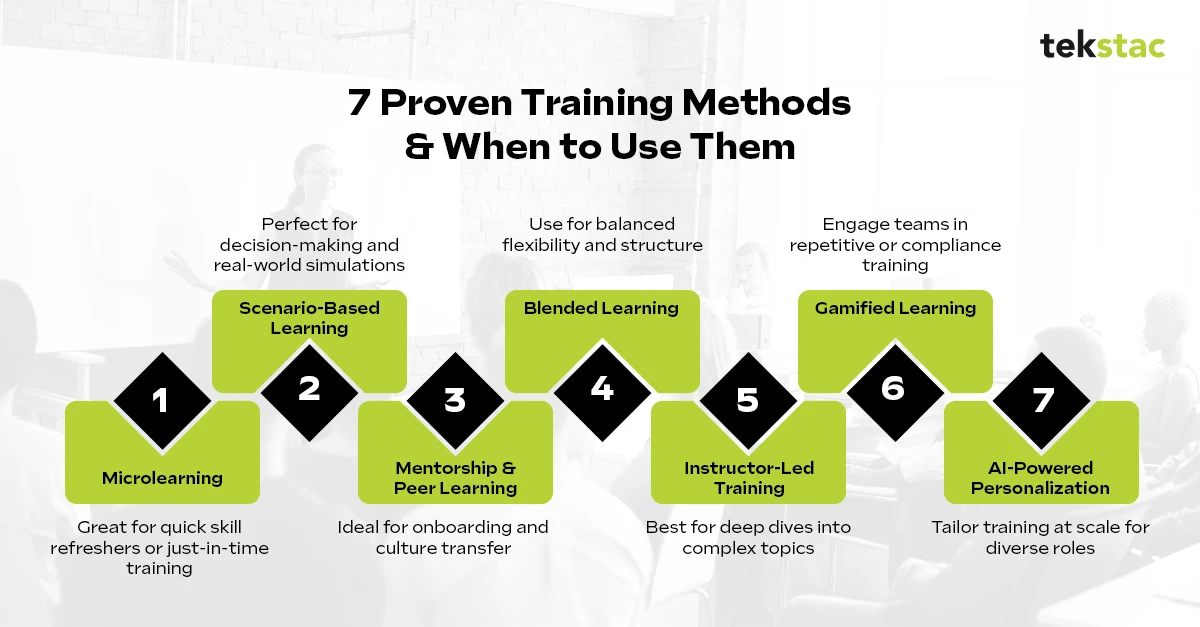
1. Microlearning: The Employee Training Method for Bite-Sized Brilliance
What if your team could learn something valuable in the time it takes to grab a coffee?
That’s the promise of microlearning- short, focused learning modules designed to fit seamlessly into the flow of work.
Whether it’s a quick how-to video, a flashcard-based quiz, or a mobile-friendly infographic, microlearning breaks down complex topics into digestible formats that stick. It’s accessible, time-efficient, and perfect for modern learners juggling multiple priorities.
When to Use It:
- For just-in-time learning, like mastering a new tool right before a project
- During onboarding, to prevent information overload
- As refresher modules to reinforce previous training
According to a 2025 report by Gitnux, microlearning can improve knowledge retention by up to 80% over traditional training methods.
2. Scenario-Based Learning: Experiential Employee Training That Builds Confidence
Scenario-based learning places employees in realistic, job-relevant situations that challenge their decision-making, problem-solving, and emotional intelligence. Instead of passive content consumption, learners are required to act and see the consequences of their choices.
Think of a customer service rep navigating a complaint or a healthcare worker handling a patient emergency in a simulated environment. This method makes learning experiential, memorable, and context-rich.
When to Use It:
- For customer-facing teams to build confidence under pressure
- In compliance-heavy industries where decisions carry legal or financial risks
- To train employees in handling conflict, negotiation, or ethical dilemmas
3. Mentorship and Peer Learning: Social Learning Methods That Build Leaders
Sometimes, the best way to learn isn’t through a course- it’s through conversation. Mentorship and peer learning foster organic knowledge transfer, collaboration, and emotional support in the workplace.
Whether it’s a formal mentorship program or casual peer-to-peer learning sessions, this method nurtures a culture of openness, curiosity, and mutual growth. It also builds internal networks and drives retention.
When to Use It:
- When grooming future leaders or high-potential employees
- To help new hires adapt faster by learning from experienced colleagues
- During cultural or organizational transitions, where emotional insight is key
A 2024 report by WorldMetrics.org indicates that companies with structured onboarding programs improve new hire retention by 82%
4. Blended Learning: A Flexible Employee Training Method for Modern Workforces
Blended learning combines the convenience of digital content with the human touch of instructor-led sessions. This approach caters to diverse learning styles- allowing some to learn by watching videos, others through hands-on practice, and still others by engaging in group discussions.
It’s one of the most versatile training methods, ideal for multi-stage learning journeys where theoretical knowledge needs to be paired with real-world application.
When to Use It:
- For large-scale onboarding programs across geographies
- In role-specific certifications or internal promotions
- When rolling out complex systems, tools, or process changes
This hybrid approach ensures consistency without compromising flexibility, an essential trait in hybrid or remote-first workplaces.
5. Instructor-Led Training: Deep Learning for Critical Employee Skills
Despite the digital shift, Instructor-Led Training (ILT) still holds incredible value, especially when the stakes are high. Whether conducted in-person or virtually, ILT brings experts directly to the learners, offering real-time guidance, personalized feedback, and an interactive format.
This method is ideal for collaborative activities like workshops, group roleplay, or troubleshooting sessions. It encourages questions, builds confidence, and fosters team cohesion.
When to Use It:
- For leadership training, soft skills development, or executive coaching
- In industries with strict compliance regulations (e.g., finance, aviation, pharma)
- When launching new tools, systems, or cross-functional initiatives
ILT works best when used strategically, supported by pre-reads or eLearning, followed by post-session exercises or assessments.
6. Gamified Learning: A Fun and Effective Employee Training Strategy
Gamification adds fun, motivation, and healthy competition to training by using elements like badges, points, leaderboards, and progress bars. But beyond just “fun,” gamification taps into intrinsic motivators- such as achievement, status, and recognition.
It’s one of the most engaging employee training methods, particularly effective in building consistency and driving behavior change.
When to Use It:
- For sales and customer service teams to boost energy and competition
- When rolling out repeat training modules like safety or HR policies
- To reinforce learning through simulations or mobile-based quizzes
Gamified platforms can also track learning progress in real time, giving L&D teams valuable data on engagement and gaps.
7. AI-Powered Personalized Learning: Smart Training Method for Scalable Growth
One-size-fits-all training doesn’t work anymore, especially in organizations with diverse roles, career goals, and skill sets. Enter AI-powered personalized learning.
By analyzing an employee’s current skills, behavior, and performance, AI can recommend customized learning paths, adjust difficulty levels, and even predict what topics they’ll need next. It’s like having a personal tutor for every employee, at scale.
When to Use It:
- For large enterprises looking to reskill or upskill across roles
- In digital transformation projects where speed and scalability matter
- For long-term employee growth and career pathing
According to a 2024 report by Virtasant, integrating AI into corporate training programs has led to a 57% increase in learning efficiency, significantly boosting employee productivity.
The Bottom Line: Transform Your Workforce with the Right Employee Training Methods
Organizations that treat training as a strategic tool- not a checkbox- build resilient, skilled, and engaged workforces. They retain top talent, respond to change faster, and outperform competitors.
And it all starts with choosing the right employee training methods for the right moments.
So, the next time you plan a training rollout, ask yourself: Is this the right method for this moment? Because how you train may just determine how far your people, and your company can go.
While we’ve explored specific training methods here, understanding how these fit into a broader organizational strategy is crucial
Discover the bigger picture of how modern organizations are revolutionizing employee training and development – at scale, with speed, and strategic intent.
FAQs on Employee Training Method
1. What is the best training method for strength?
The best method for building strength is progressive resistance training, focusing on gradually increasing weight, intensity, or difficulty over time.
2. How can AI improve employee training methods?
AI enhances training by personalizing learning paths, predicting skill gaps, and providing real-time feedback to boost engagement and retention.
3. Why should companies invest in modern employee training methods?
Modern training methods increase productivity, reduce turnover, and future-proof workforce skills, aligning learning with business goals.
4. Which training method is most effective?
The most effective method depends on goals — but blended and AI-powered learning deliver the best results by combining flexibility with personalization.
AI Trends Shaping L&D: Revolutionizing Workplace Learning in 2025
In 2025, the pace of change has exploded. Emerging AI trends in L&D are redefining every aspect of workplace operations and learning. Yet, many organizations are still training like it’s 2010.
The world of Learning and Development (L&D) is at a turning point, as outdated systems clash with the urgent need for workplace upskilling with AI, and companies struggle to keep pace with the demands of digital transformation in L&D.
While AI promises hyper-personalization, real-time insights, and automation at scale, the uncomfortable truth is that most businesses are stuck delivering cookie-cutter training that satisfies no one.
The rise of AI trends in learning tech has made it clear: generic learning paths are obsolete. Workers demand training that reflects their roles, goals, and learning styles. Instead, they’re handed recycled slide decks and linear modules that neither engage nor empower.
In an era where 9 out of 10 of executives say the skills gap is a critical business issue, clinging to traditional L&D models isn’t just inefficient. It’s a risk to survival.
What L&D Leaders Must Know: 6 Game-Changing AI Trends
1. The Collapse of One-Size-Fits-All Learning
Let’s start with the cold reality: most L&D systems are failing.
According to the 2025 LinkedIn Workplace Learning Report, 71% of L&D teams are only experimenting with AI, not fully leveraging AI in driving measurable outcomes.
This hesitation has consequences. When 70% of training programs fail to deliver measurable outcomes, it’s not a user problem. It’s a system problem.
Current systems offer little more than completion data. They can tell you who clicked “Next,” but not who actually learned, retained, or applied anything.
Meanwhile, over half of learners abandon online courses midway, citing poor alignment with their roles. And with automation reshaping industries, job requirements evolve faster than most training teams can respond.
The result?
Disengaged employees, wasted budgets, and unmet business goals.
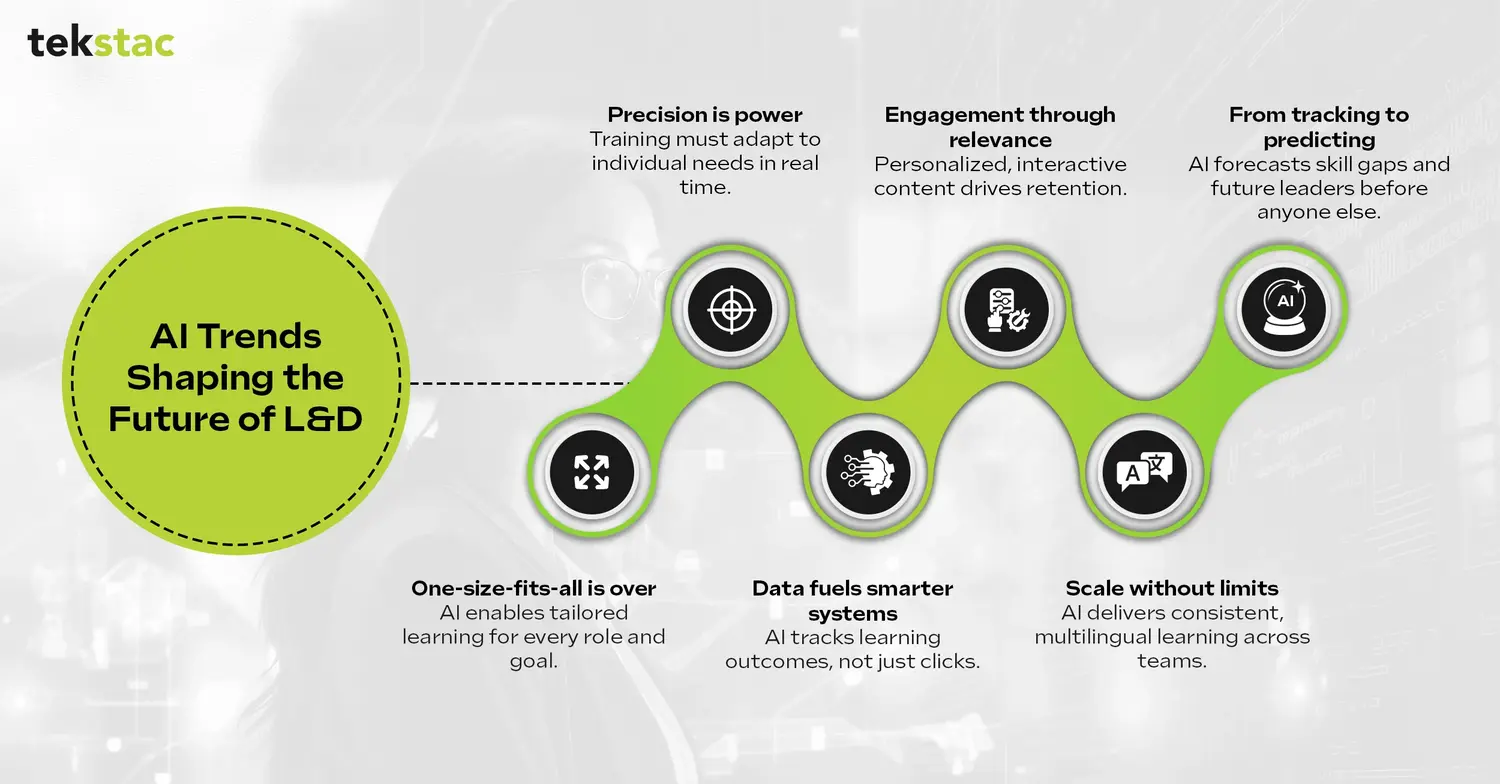
2. Why Precision is No Longer a Luxury
In a world moving at the speed of light, delivering personalized training isn’t just a “nice to have” anymore. It’s mandatory. L&D systems must know more than job titles.
They need to understand learning behaviors, career goals, and real-time performance data.
In companies that have embraced it, training time has dropped, skill application has soared, and employee retention has improved.
Deloitte reports that organizations using AI in L&D have seen a 24% jump in productivity and a 28% improvement in retention. At its core, this is transformation, not just tech.
3. Smarter Systems Start with Smarter Data
Here’s what legacy systems don’t do: connect learning to business outcomes. AI-powered platforms, on the other hand, don’t just deliver content, they learn from it. They track not just engagement but impact.
Leveraging AI, modern systems can track how skills evolve over time, pinpoint where progress is stalling, and recognize who’s ready for a promotion—something that forward-looking workplace learning strategies are now built around. It goes beyond just training, it helps shape a smarter, data-driven talent strategy.
By year two of using these systems, organizations report smarter decision-making, less rework, and clearer succession planning.
By year three, AI-powered learning starts surfacing insights that no spreadsheet ever could: like which departments are overperforming, which skills correlate with project success, or where burnout is brewing.
This isn’t hypothetical.
This is happening now.
4. Engagement That Feels Like Growth, Not Obligation
People don’t hate learning.
They hate irrelevant learning.
AI fixes this by making training feel personal, and customized for each individual so they feel it’s relevant for them but not forced.
It gives instant feedback, transforms lessons into interactive stories, and builds safe simulations where employees can practice without fear of failure.
Platforms like Tekstac are already using this approach.
With adaptive learning paths, localized content, and role-based recommendations, learners don’t just consume content, they experience it.
According to PwC, 72% of learners now prefer AI-based training formats over traditional methods. It’s not just more fun. It works.
5. Scale Without Compromise
Traditional L&D hits a ceiling fast. More people means more facilitators, more costs, more logistics. But with AI, scaling is seamless.
Whether you’re training 10 or 10,000, the experience remains consistent and high-quality.
Deloitte found that companies using AI for training cut costs by 35%, while simultaneously increasing reach and effectiveness.
Multilingual support, auto-translation, and real-time content adaptation mean global teams can access the same content, tailored to their needs and context.
This levels the playing field and ensures inclusivity, a critical but often neglected component of enterprise learning strategies.
6. From Tracking to Predicting: The Real ROI of AI in L&D
It’s no longer enough to ask whether someone completed a course.
The real question is: did it make a difference?
With AI, you no longer have to guess. You can see skill proficiency rising, time-to-productivity falling, and internal promotions accelerating.
One study by the Brandon Hall Group revealed that AI-based learning led to 42% higher retention and 55% faster skill acquisition.
In forward-thinking companies, L&D leaders don’t chase KPIs, they shape them.
Predictive dashboards now alert managers to emerging leaders, identify team-level skill gaps, and recommend training before performance dips.
It marks a shift from learning to strategic talent development.
The Platform That Delivers All This: Tekstac
At the center of this transformation is Tekstac.
It’s not just another learning platform, it’s a complete AI-driven learning intelligence system.
Built for scale, flexibility, and performance, Tekstac integrates content creation, real-time analytics, and adaptive delivery into one seamless experience.
From SHRM-aligned learning paths to auto-generated content and knowledge checks, Tekstac personalized every aspect of training.
It identifies where each learner stands, maps growth paths, and shows HR and leadership where the talent pipeline is headed. It connects every learning act to a real business outcome, be it faster onboarding, increased internal mobility, or improved customer results.
And the impact is measurable. Companies using Tekstac report up to 48% reduction in learning cycle time and 65% improvement in content relevance for high-skill roles like software development.
Whether you’re a tech giant, a healthcare provider, or a logistics firm, Tekstac adapts to your needs, your teams, and your goals.
Final Word: L&D is No Longer an Expense. It’s Your Advantage
The companies winning in 2025 are those who stopped viewing training as a checkbox and started seeing it as a growth engine.
They moved from one-size-fits-all to one-path-for-each. From passive completion to active transformation. And from static dashboards to living, predictive maps of workforce capability.
So here’s the truth: if your training platform can’t personalize, can’t scale, and can’t connect to business outcomes, it’s not slowing you down, it’s keeping you behind.
The shift to AI-powered learning isn’t just smart.
It’s inevitable.
Make the move to a platform that sees your people not just as learners, but as your competitive edge.
A platform that doesn’t just keep up with the future, but creates it.
Tekstac isn’t the next step. It’s the leap forward.

